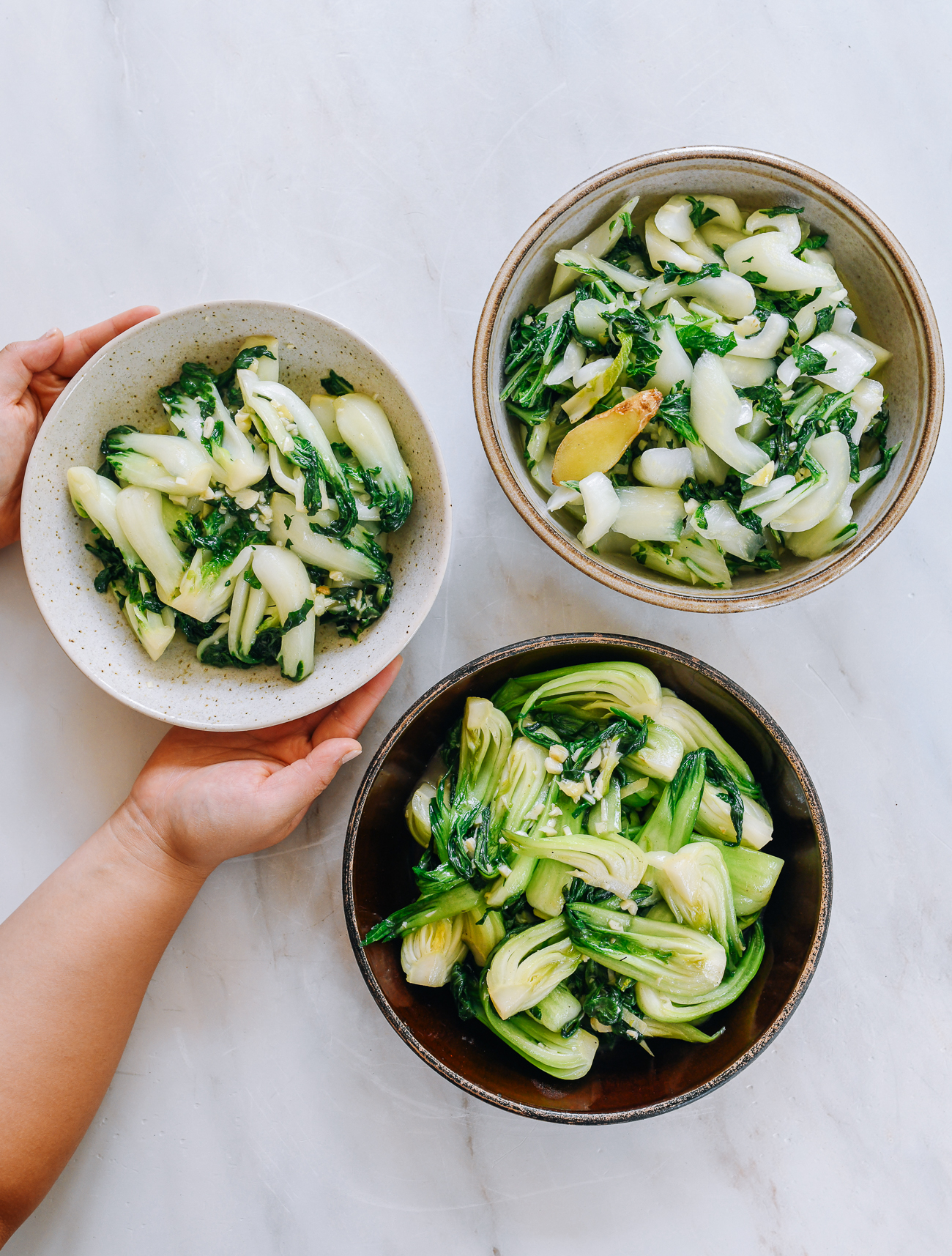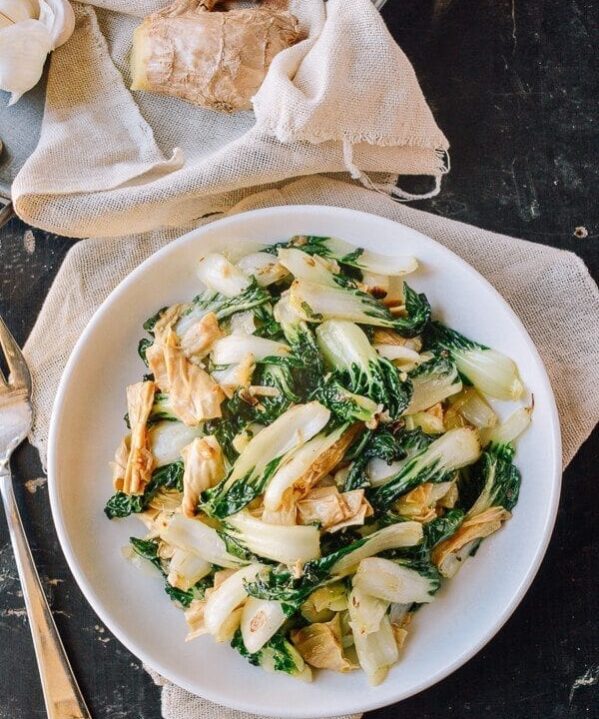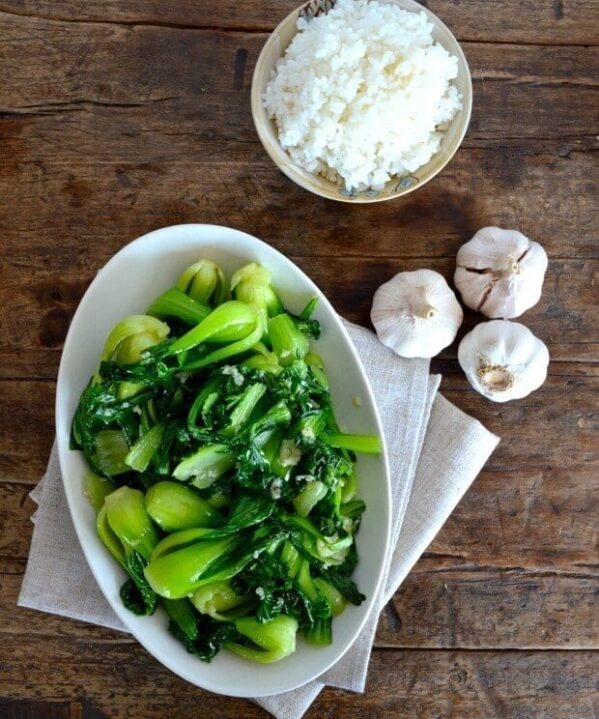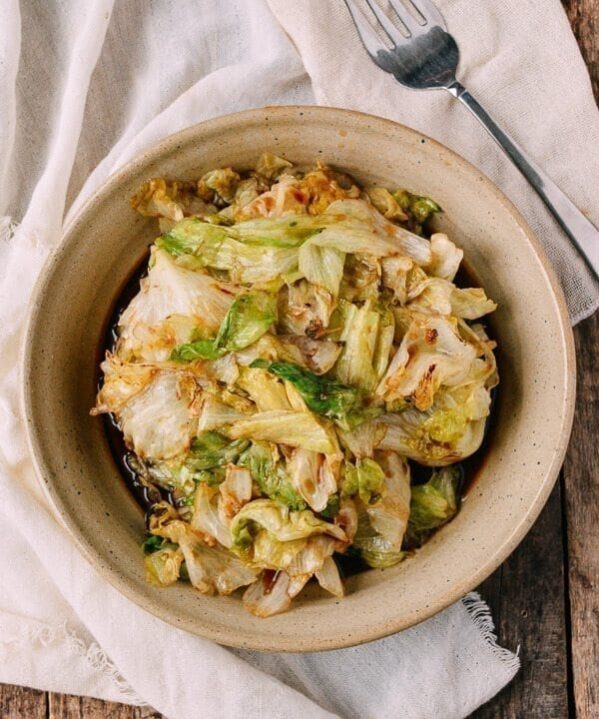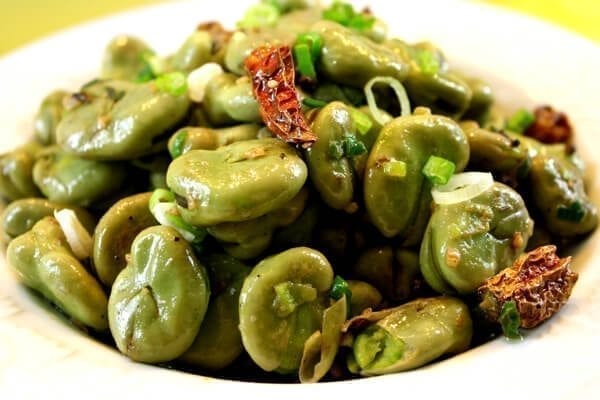We all need a go-to green vegetable side dish to go with any main course, and this bok choy stir-fry recipe is a great candidate.
Today, we’re sharing restaurant tips and tricks to make a delicious and simple bok choy stir-fry at home. It really is a great all-purpose side for any kind of meal! (It’s also vegan!) We serve it with both Chinese dishes as well as non-Chinese recipes that need an infusion of veggies.
It’s one of the easiest recipes we have on the blog, once you learn a few basics that make your stir-fried veggies stand out!
NOTE:
This post was originally published on December 11, 2015. We have since updated the recipe, showing you how to cook different types of bok choy, and also adding re-tested and perfected techniques that we’ve learned over the years. We also have new photos, metric measurements, and nutrition information. If you’d like to reference the original version of the recipe that my dad posted all those years ago, scroll down to the bottom of the post. Enjoy!
How Do Chinese Restaurants Get Their Bok Choy Stir-fry So Tasty?
Restaurants have the advantage of having super hot commercial wok burners that pack in the wok hei (that subtle smoky, savory aroma that screams umami!).
But they also use a lot of oil, salt, and garlic, and take the extra step of adding ginger to their stir-fried bok choy. The ginger really makes a big difference!
I’ve also found that a lot of our favorite Chinese restaurants will add just a little bit of cornstarch slurry to give the bok choy some sauciness, with a glistening coating that entices you as it hits the table. It’s a step that we’ve factored into this recipe!
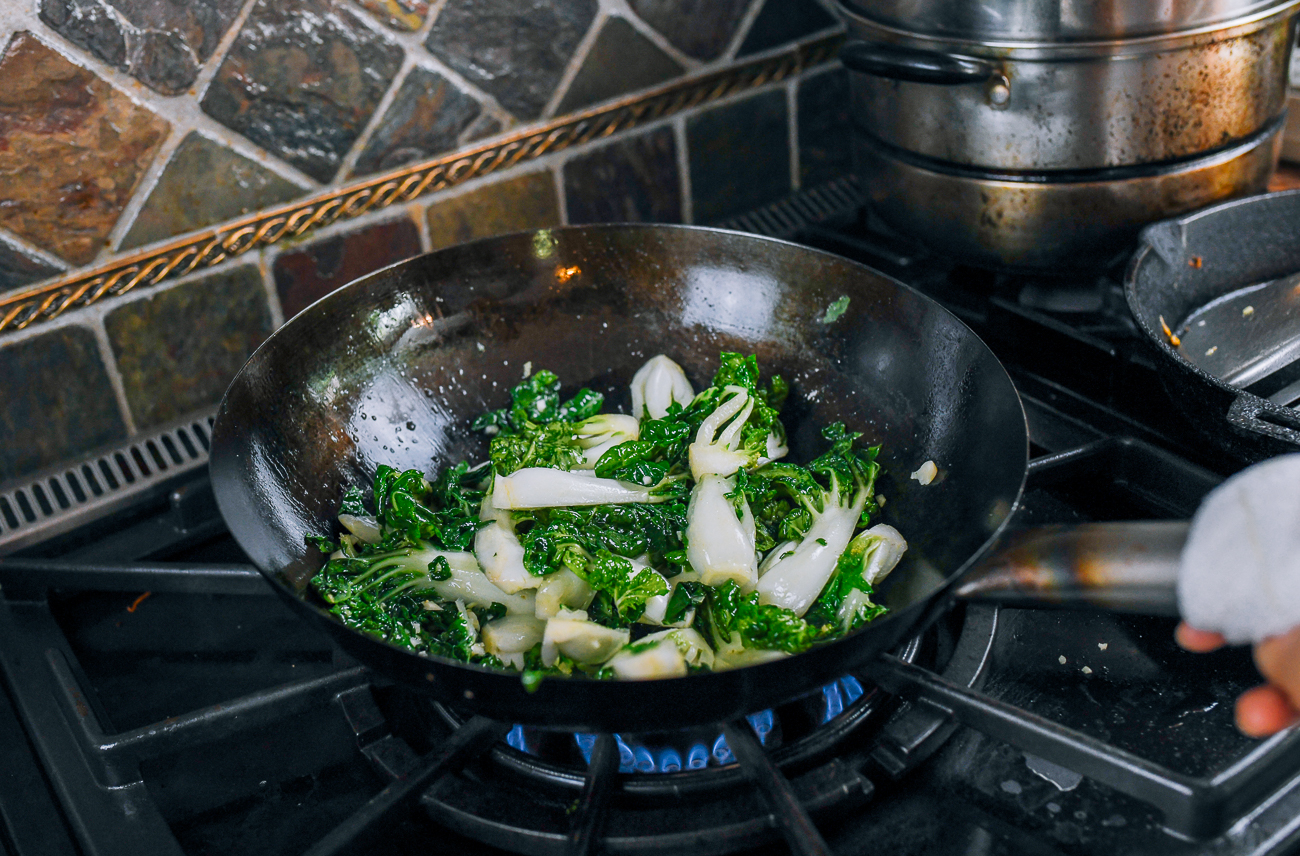
Not to be discounted as well is the addition of MSG to some restaurant dishes. MSG amplifies the savory flavor of various dishes, and leafy green stir-fries are one type of dish that really benefits from it. We’ve included it as an optional ingredient to really pump up the flavor of your bok choy stir-fry.
A Note on MSG
We know MSG is a controversial ingredient, but many of its supposed negative effects have been debunked by science. Read more about our stance on MSG here. Of course, it is always totally optional.
Your Checklist for a Perfect Bok Choy Stir Fry
- Thoroughly wash your bok choy. Bok choy loves to grow in sandy soil, and one of the worst things that can happen with this dish is to find that when you’re scooping the bok choy out of the wok, you hear this horrifying sound of the metal spatula scraping against sand! No one wants to crunch down on dirt or sand when enjoying their dinner. Be sure to discard any yellowing leaves or bruised stems. If a leaf is turning yellow at the edges, you can trim it away with a knife or by tearing it with your hands to cut down on food waste. Rubbing the leaves with your hands also helps to rinse away any pesticide residue. Always wash your veggies!
- Use enough oil and salt (we’ve got all the right measurements for you below). In general, you just want to use a neutral oil with a high smoke point, such as avocado oil, vegetable oil, peanut oil, or canola oil. Don’t be shy about using it either, as it makes your veggies taste great. Just think about how much oil you put in a salad dressing!
- Add some ginger! You can leave it as is, julienne it, or mince it depending on how much ginger flavor you like—we like it minced! It’s not overpowering at all!
- Make sure that you don’t burn your aromatics. You want the aroma of ginger and the sweetness of the garlic to accent your dish, but burning them can create bitterness. Remember that the cooking process is very fast—don’t walk away from the stove.
- High heat! A properly preheated wok will always result in a superior bok choy stir-fry. (You can read more about wok pre-heating and seasoning here!) If you have the wok skills to toss the bok choy in the wok over the flames of your burner, even better.
- Finish it with some cornstarch slurry. Just a little bit of cornstarch slurry makes the vegetable juices at the center of the wok into a sauce. This really magnifies all the flavors that you add! It also makes it all the more delicious with rice.
- Last but definitely not least, don’t overcook your vegetables, or you will have leftovers that you will not want to keep around! I never met anyone who said, “please cook my veggies well done” unless they didn’t have any teeth.
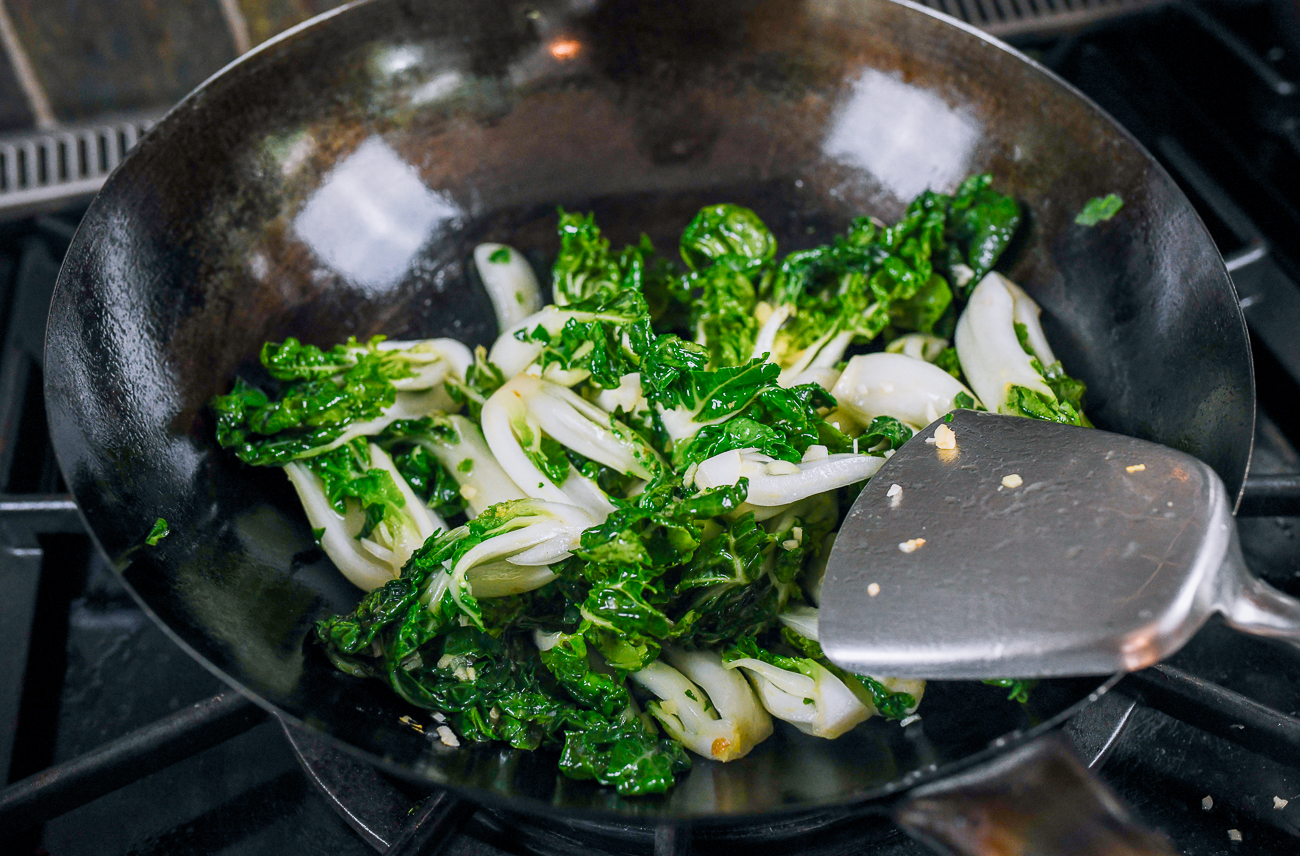
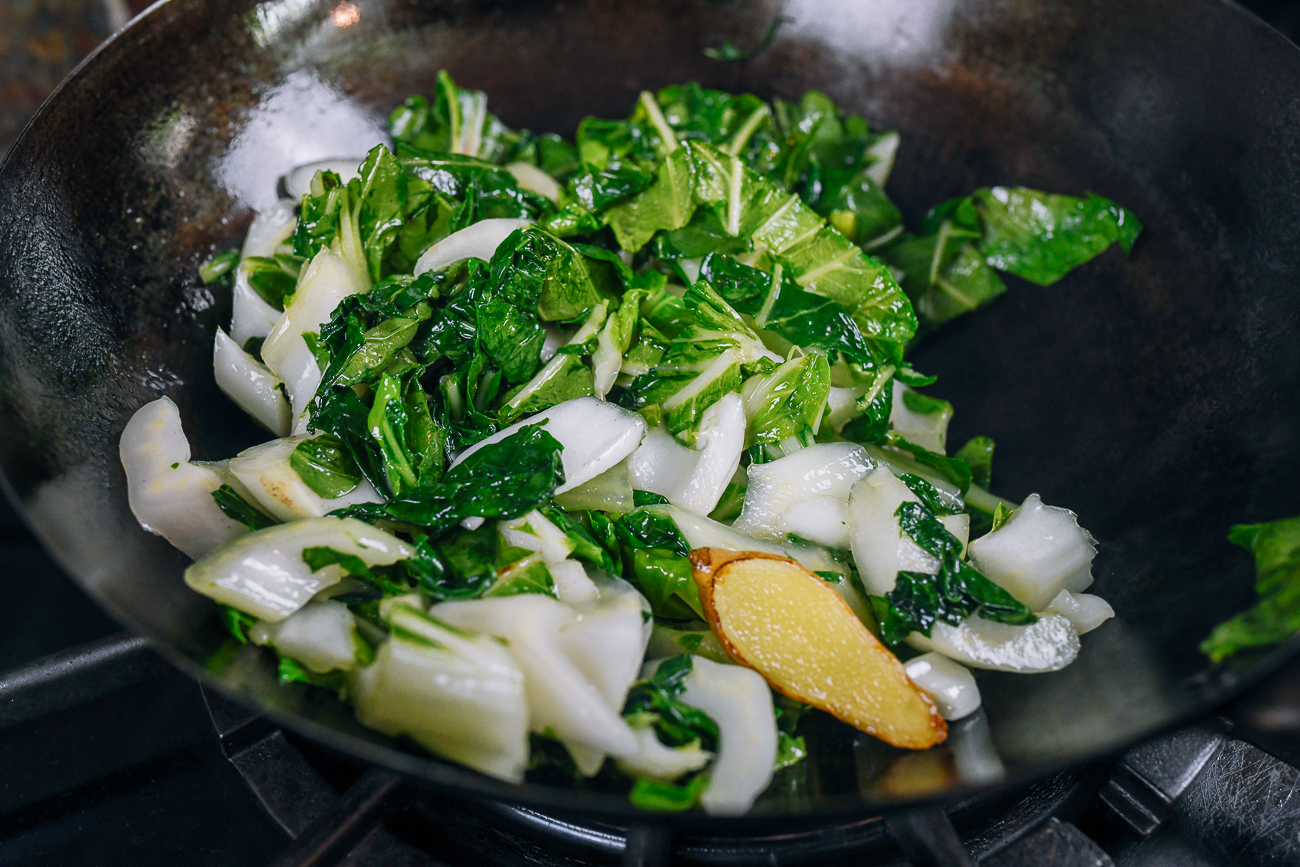
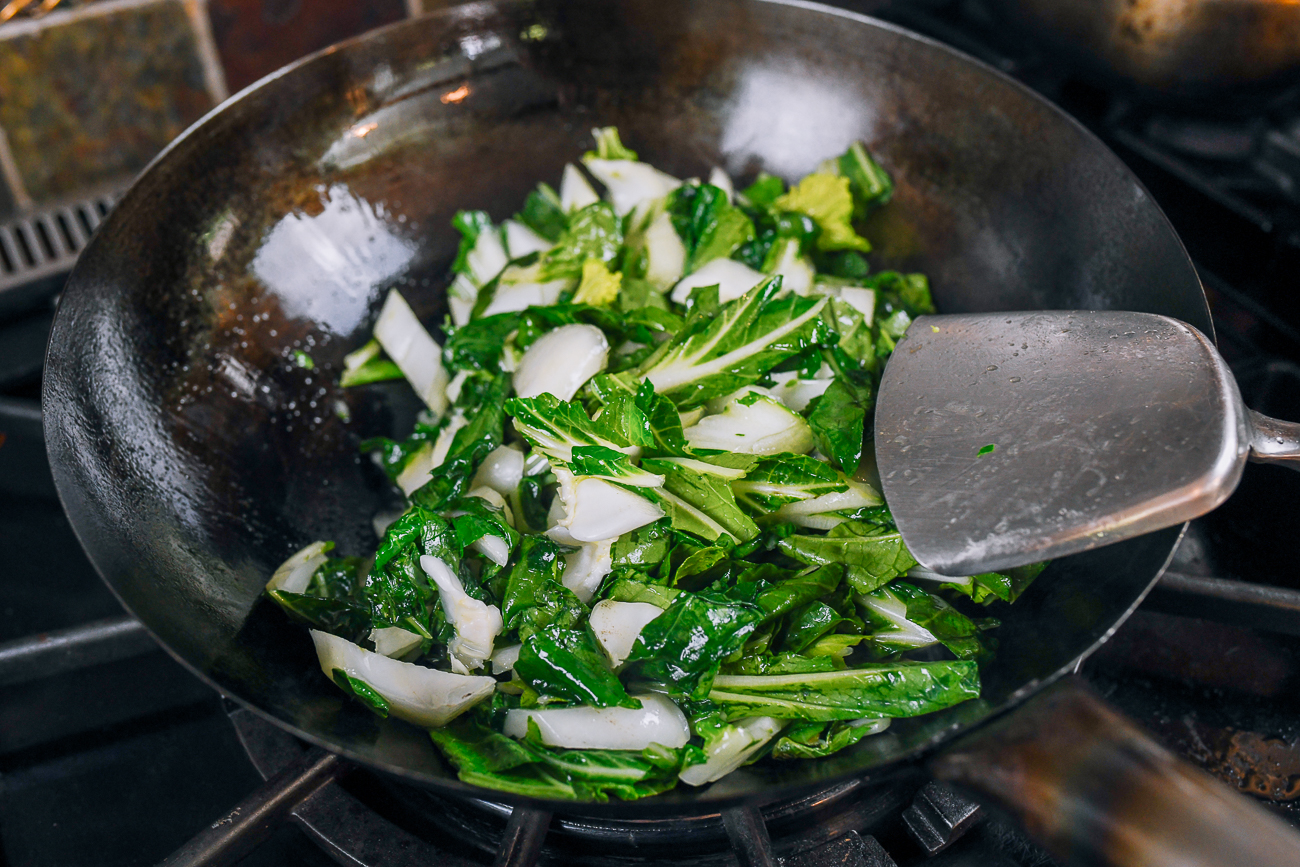
What kind of bok choy should I buy?
For this revision on my dad’s post from a while back, which used the common large variety of bok choy, I wanted to show a few different varieties side by side.
Check out our Chinese vegetables and leafy greens page, where you can get more details on the differences between bok choy varieties and other bok choy recipes.
Here, we’re working with 3 main varieties:
- Large bok choy: this is the garden variety one you can find in grocery stores across America. There is generally more stem than leaf on these, but the stems are very sweet.
- Shanghai bok choy: the bright green smooth variety with spoon-shaped leaves. These are usually picked small, which is why they may also be called “baby bok choy.”
- Dwarf bok choy: Also sometimes called “small bok choy,” or in Mandarin, 奶油白菜 (nǎiyóu báicài), which roughly translates to “cream bok choy,” these have smooth white stems and dark, curly green leaves. This one is my personal favorite!
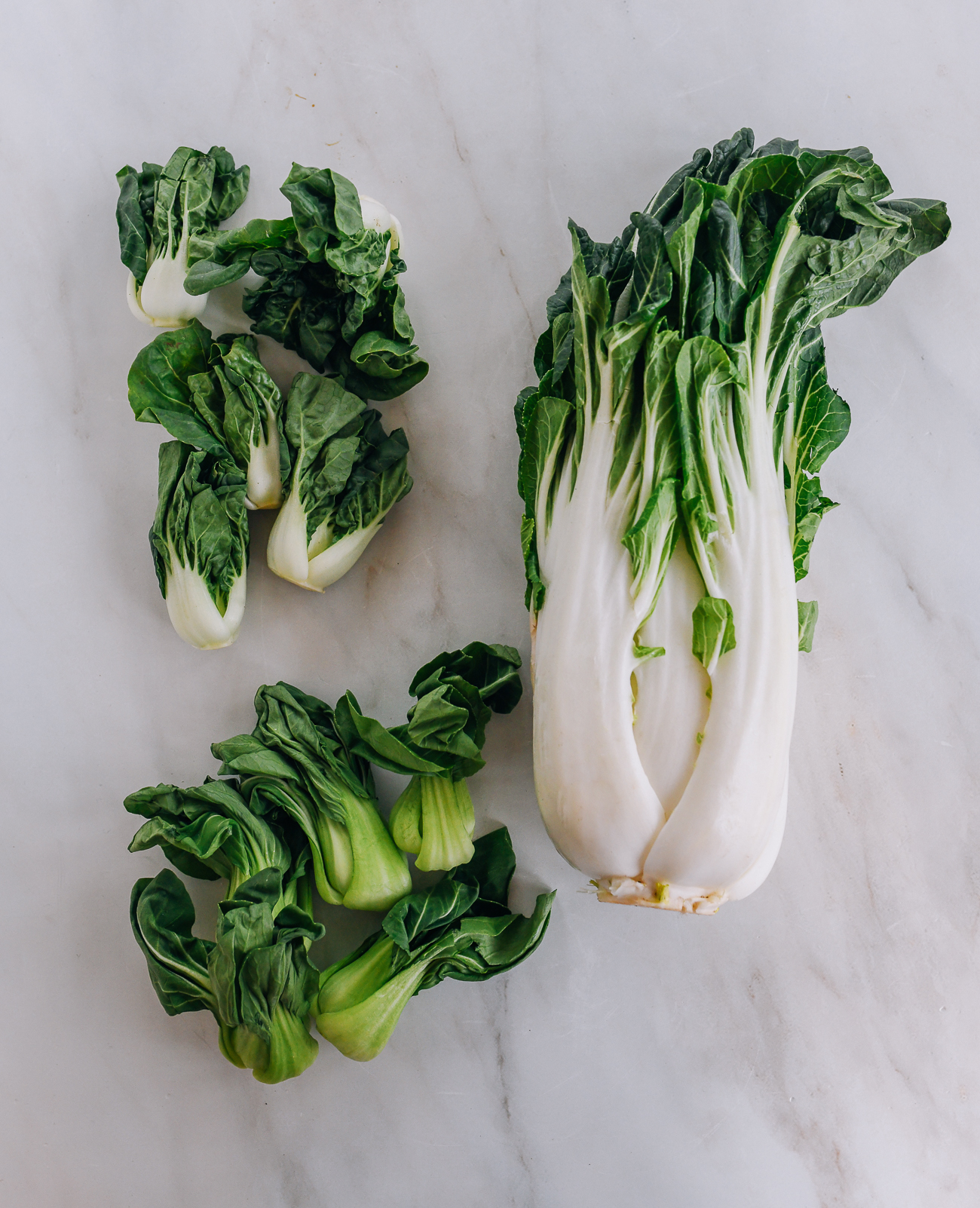
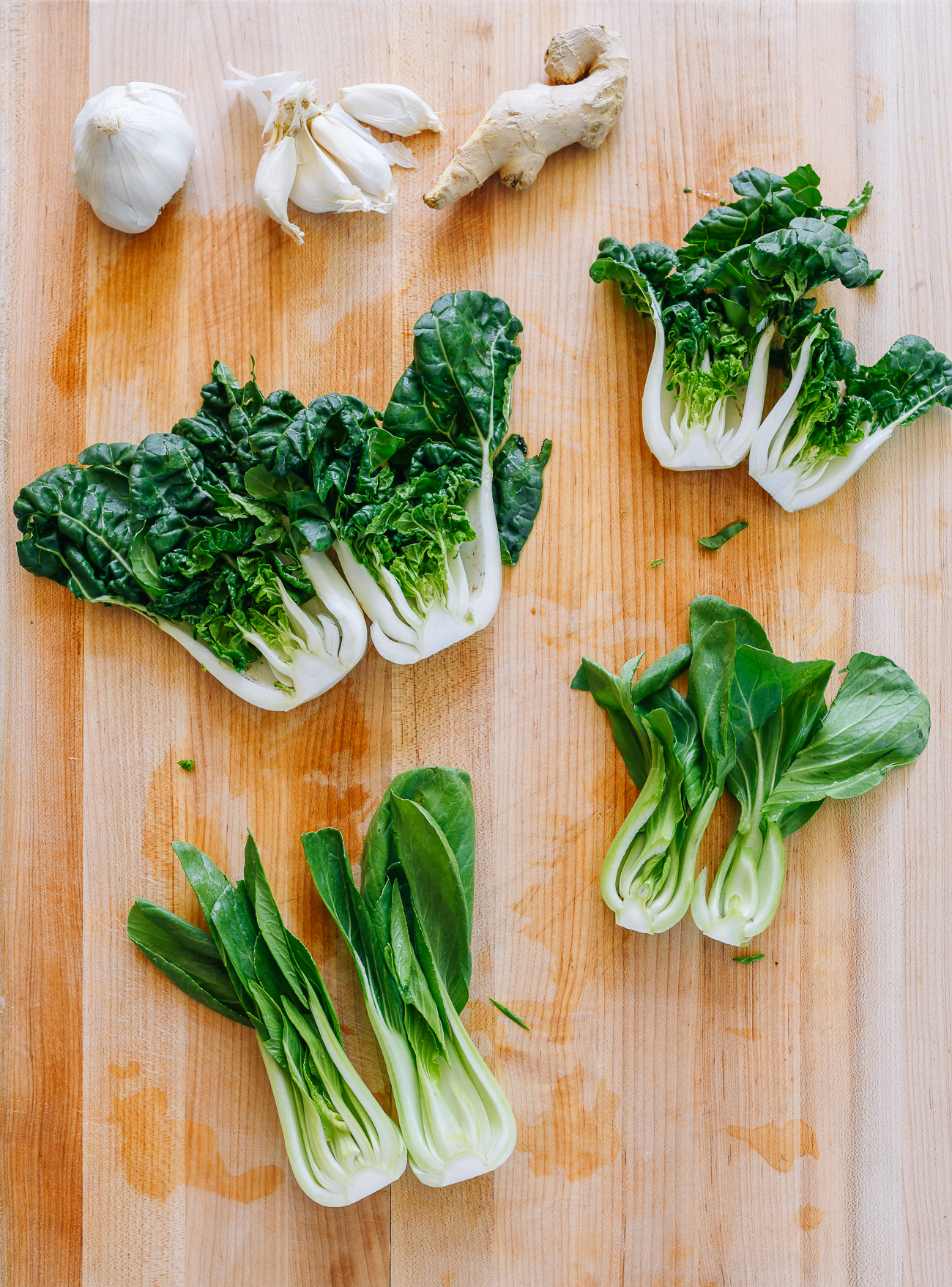
Here you can see from left to right: stir-fried large bok choy, stir-fried Shanghai bok choy, and stir-fried dwarf bok choy
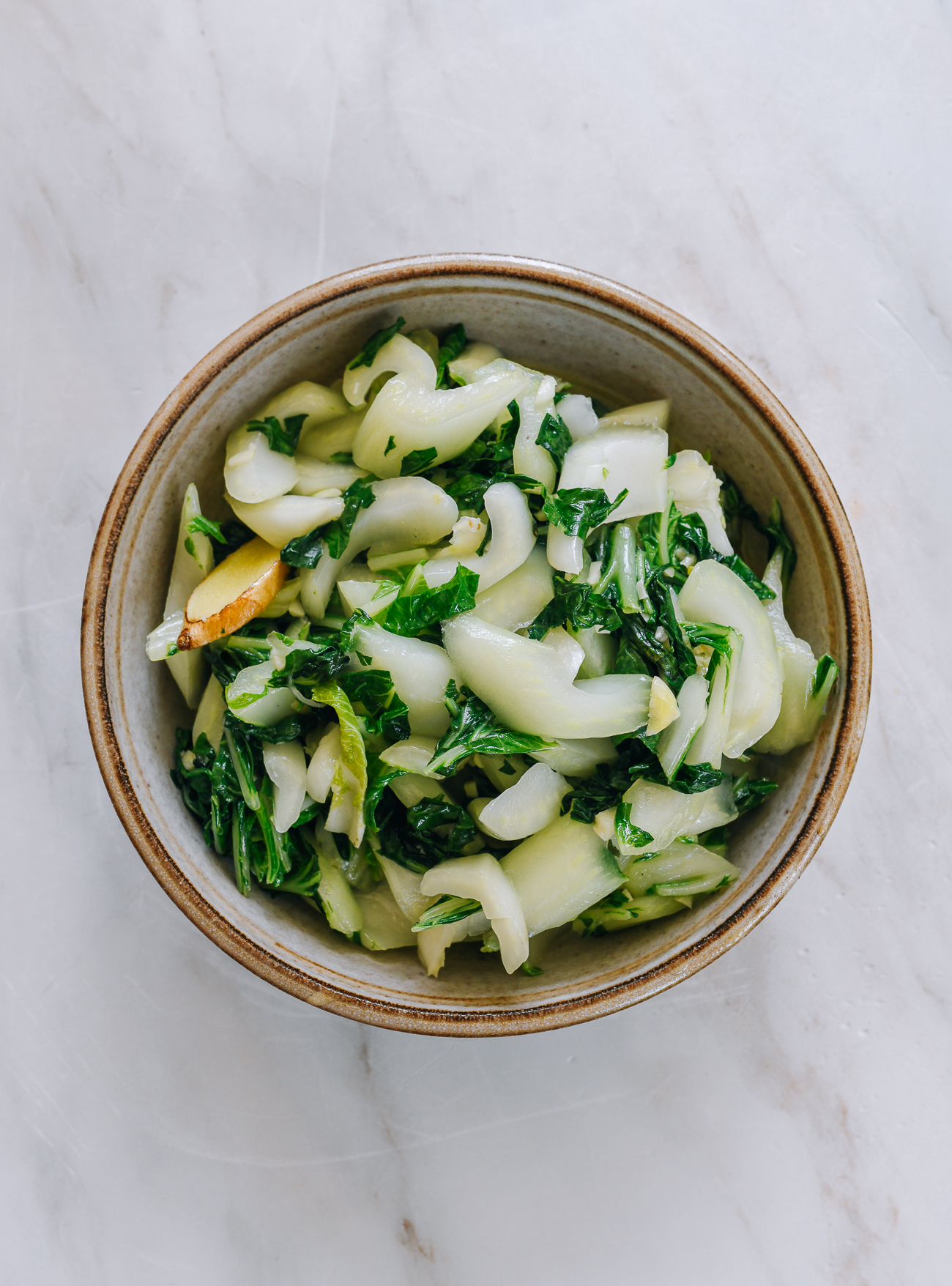
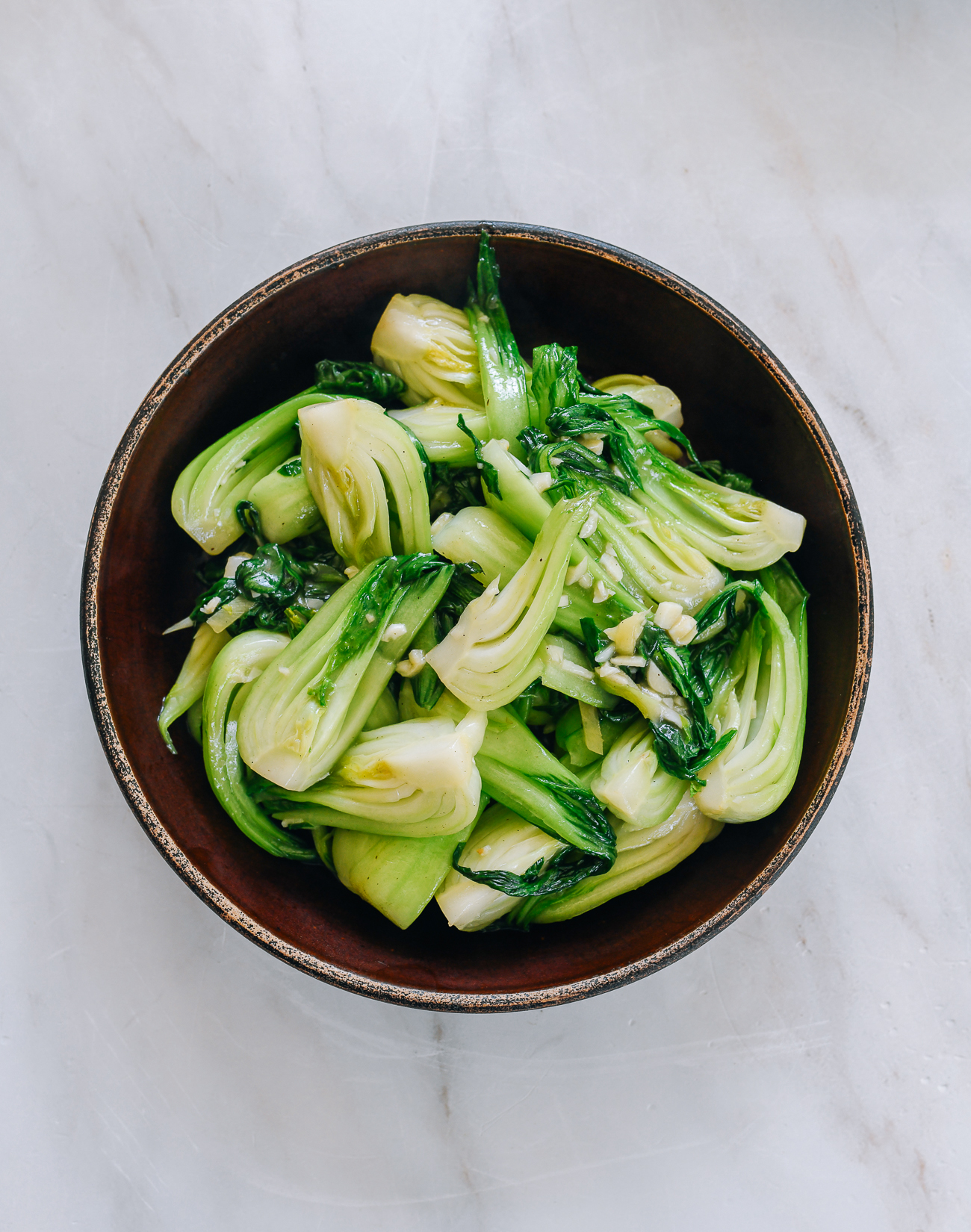
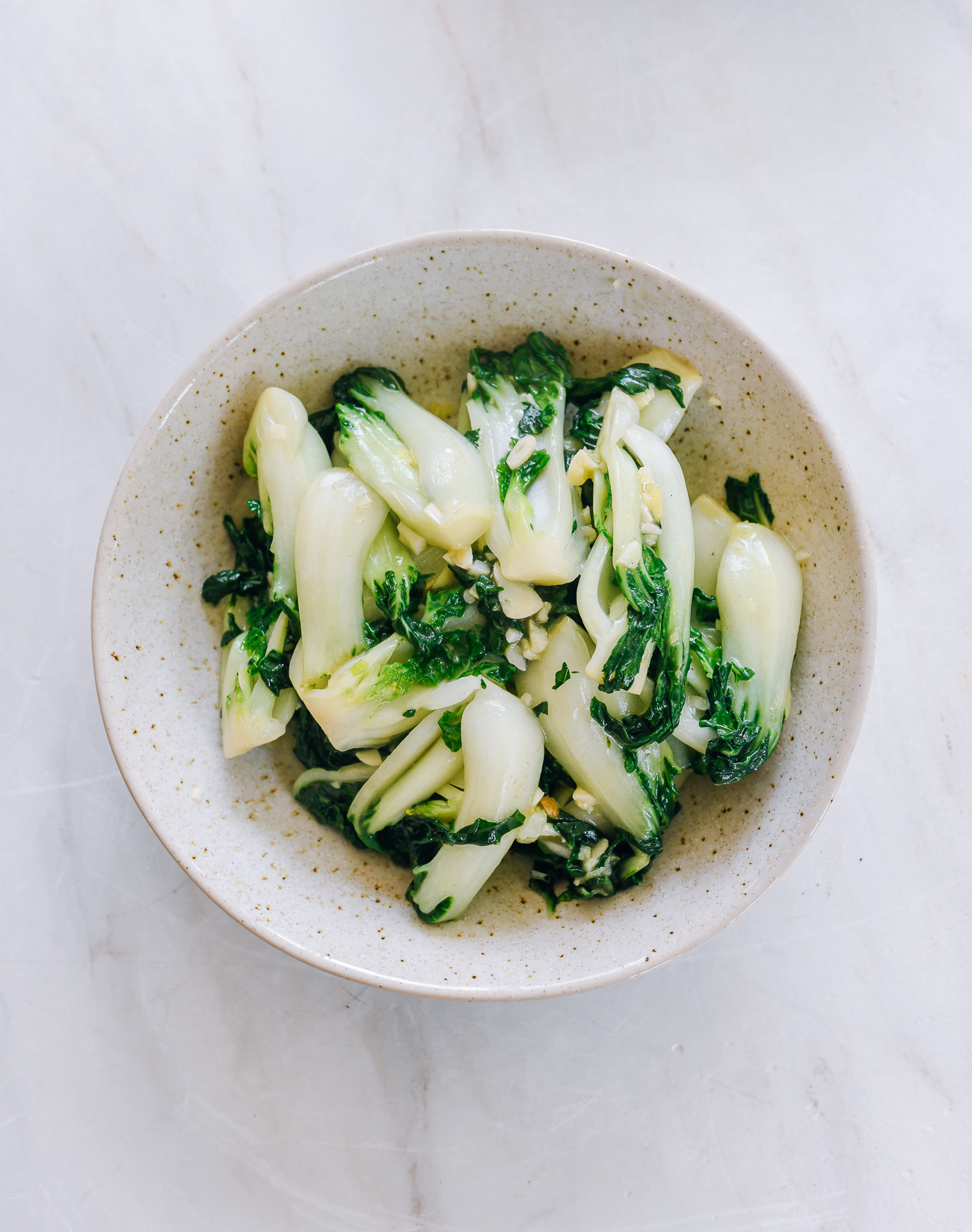
If you don’t have access to some of these varieties, you can also buy seeds online and grow bok choy in your garden. Grow it in late spring/early summer or late summer/early fall. (We find fall crops generally are more successful.)
For more information, check out Sarah’s post on How to Grow Bok Choy in our Garden/Farm section!
How Much Bok Choy Do I Need?
Most of you are cooking on an average 14-inch (35cm) wok, so that is really the limiting factor on how much bok choy you’ll want to cook at once. If you overload your wok with too much food, it won’t superheat as well, and it will be harder to stir-fry properly, let alone get a good wok hei.
Also, like any other leafy vegetable, bok choy cooks down quite a lot. We call for 1½ -1¾ pounds (a little variation won’t make or break the recipe) for a 14-inch wok. This is a good amount for 3-4 people alongside a few other dishes, and maybe 2-3 people if you’re only serving one other dish.
If you’re not looking for a family-size portion, feel free to cut the recipe in half for fewer people. You’ll get more wok hei that way as well. Simply click the number of servings in our recipe card below, then use the sliding scale to reduce the number of servings. The ingredient quantities will adjust accordingly!
Can I Pre-wash My Veggies?
If you’d like to meal-prep part of this recipe and pre-wash your veggies, make sure they are thoroughly drained and dried before storing them back in the refrigerator. You may even want to send them through a salad spinner.
Washed leafy greens can easily turn yellow in the refrigerator from excess moisture. After washing, store the veggies in a colander with a clean plastic bag wrapped around it, or in a ziploc bag. You can put a piece of paper towel in with the veggies to absorb any moisture as well. Use them within 1-2 days.
Tip!
While a good ol’ bok choy stir-fry is our favorite way to enjoy this vegetable, it’s not the only way. The sweet and crunchy leaves are also great in a salad! You can slice them thinly so they’re easy to toss and get at with a fork. The first time we tried it. we were floored! This works best with bok choy that has thicker, juicier white stems.
Also try our Bok Choy with Braised Mushrooms, which involves blanching the bok choy and serving it with a tasty sauce and dried shiitakes!
I hope this recipe becomes your go-to stir fry bok choy recipe. Here’s how you do it!
Stir-fried Bok Choy: Recipe Instructions
Prepare/Wash your Bok Choy
If using smaller bok choy, cut them into halves lengthwise. Any pieces that look a bit too big can be cut into quarters.
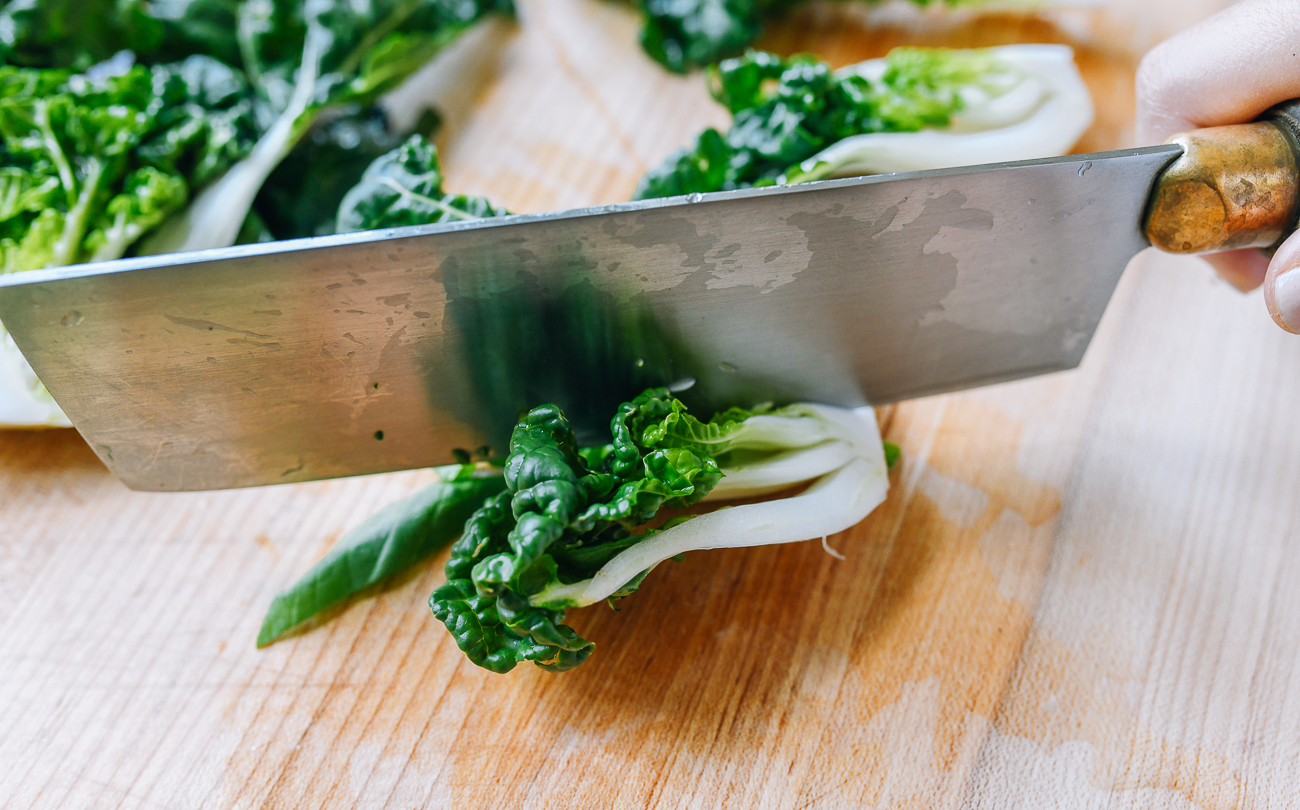

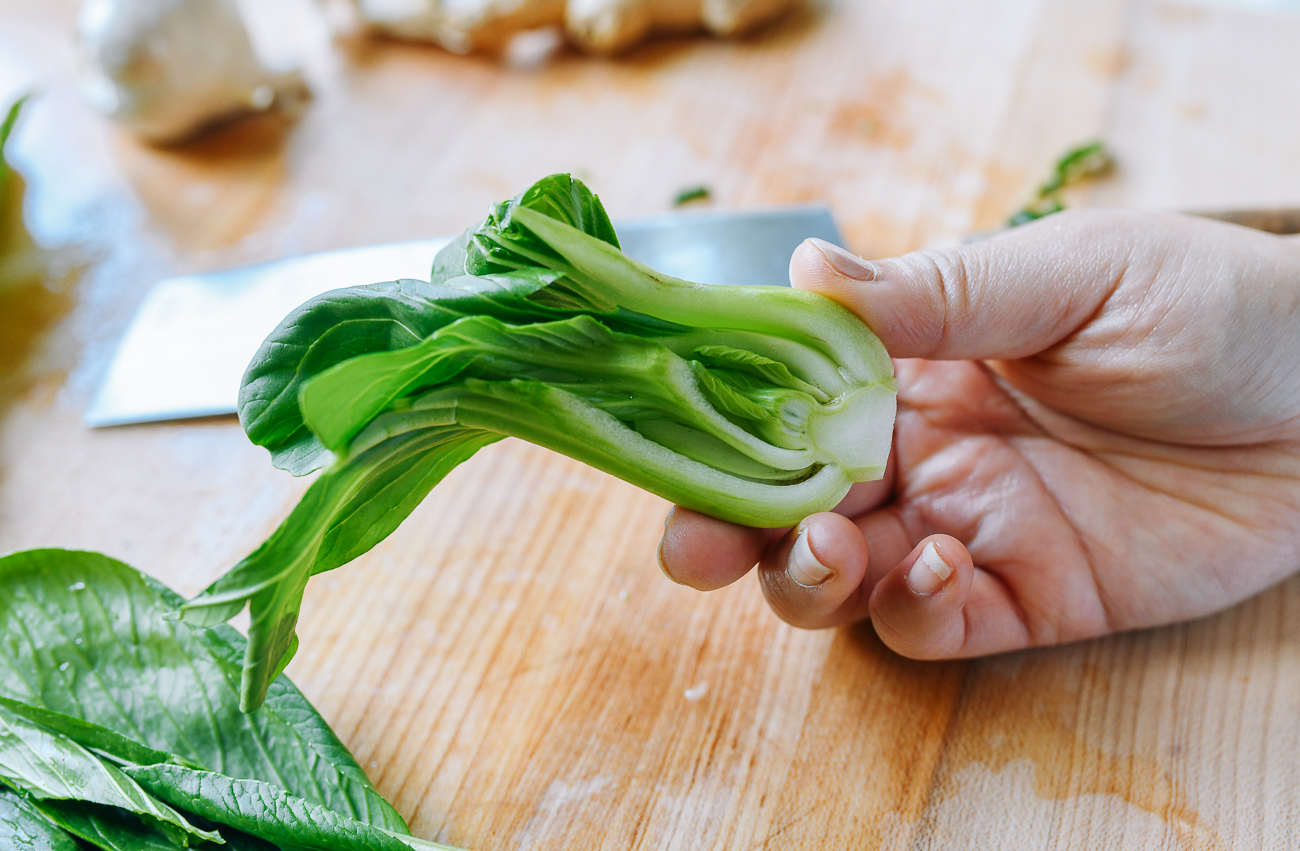
This will make them easier to eat and help loosen sand and dirt during washing.
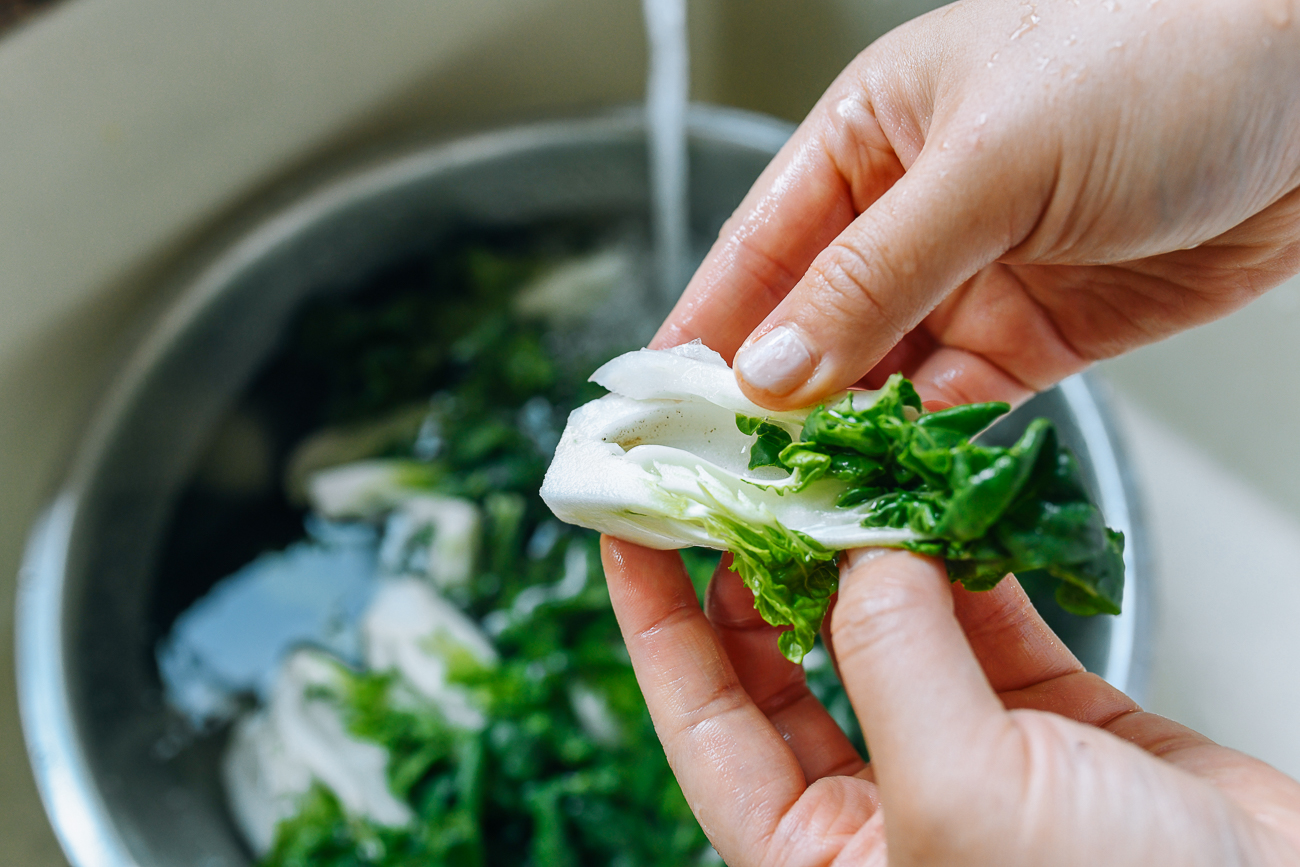
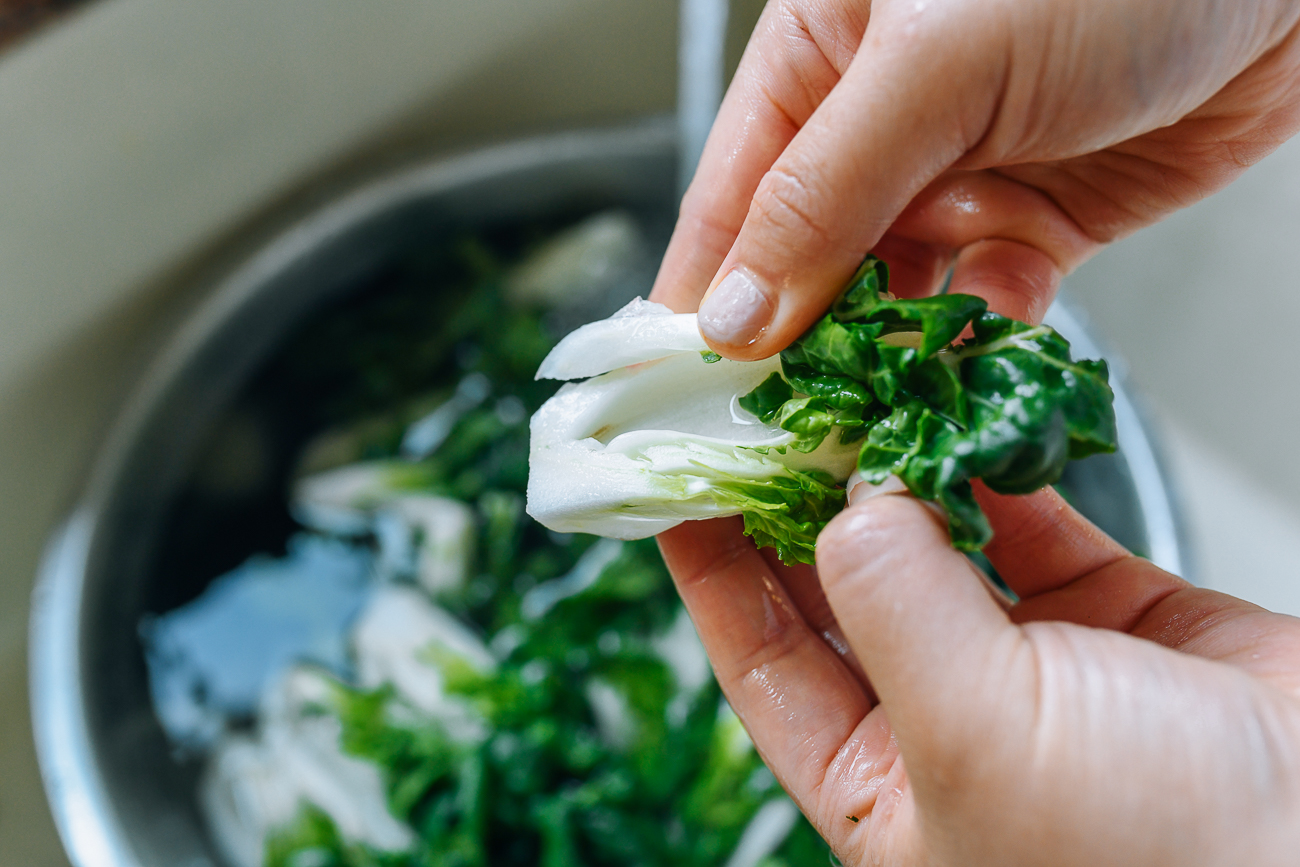
If using medium or large bok choy, separate the bulbs into individual stems. Trim away the tough base. If they’re very large, cut the bok choy at a slight angle into 1-inch bite-size pieces. Note that it’s easier to wash large bok choy leaves/stems before cutting.
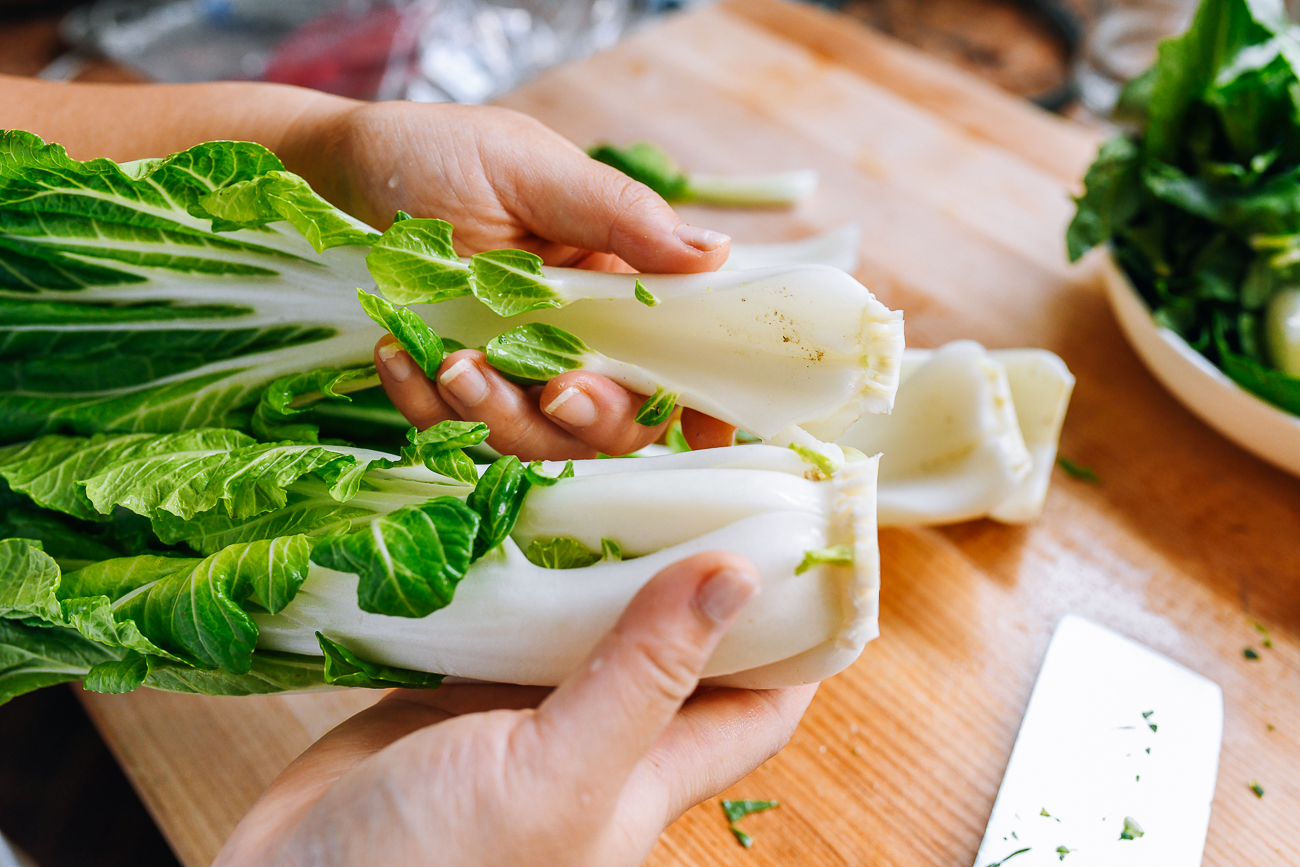
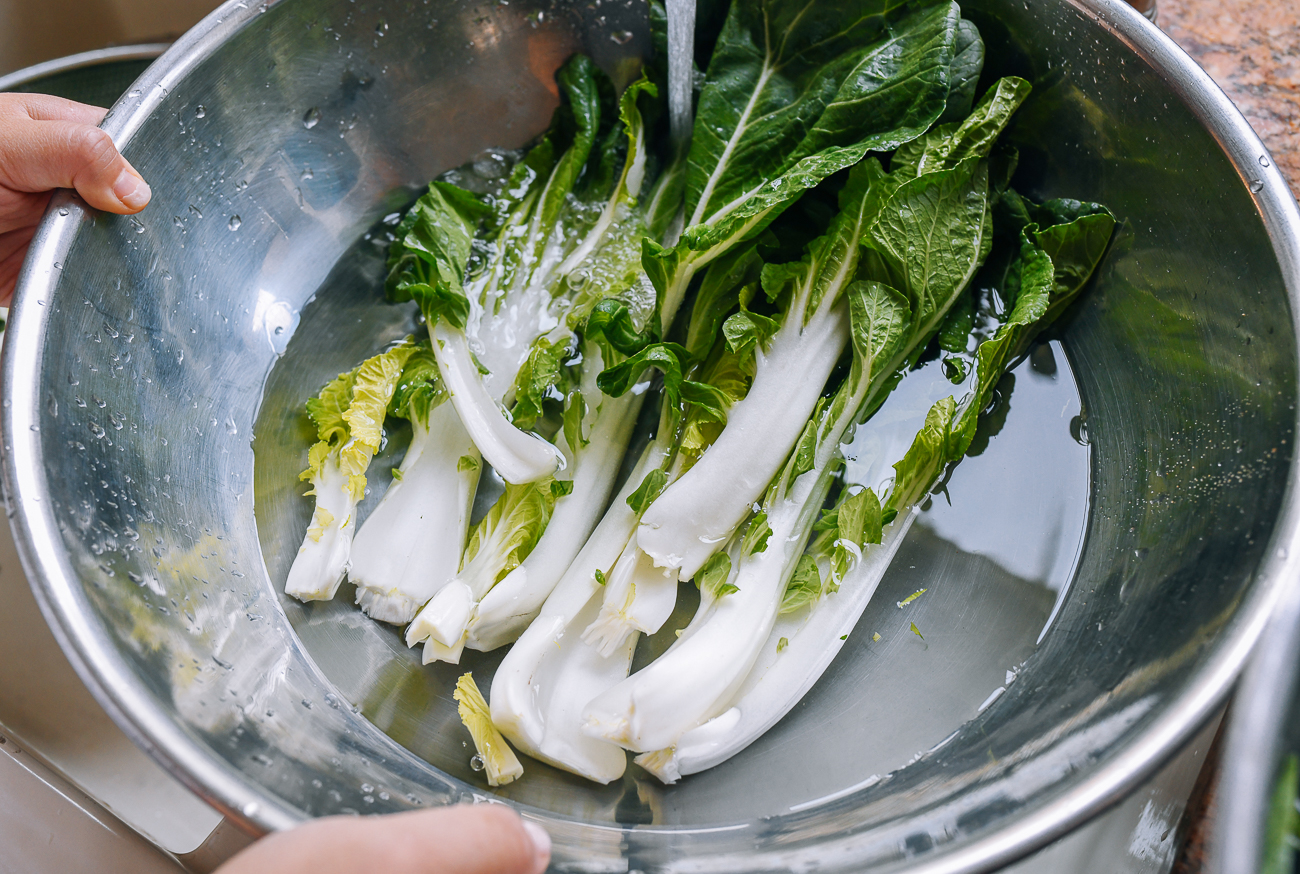
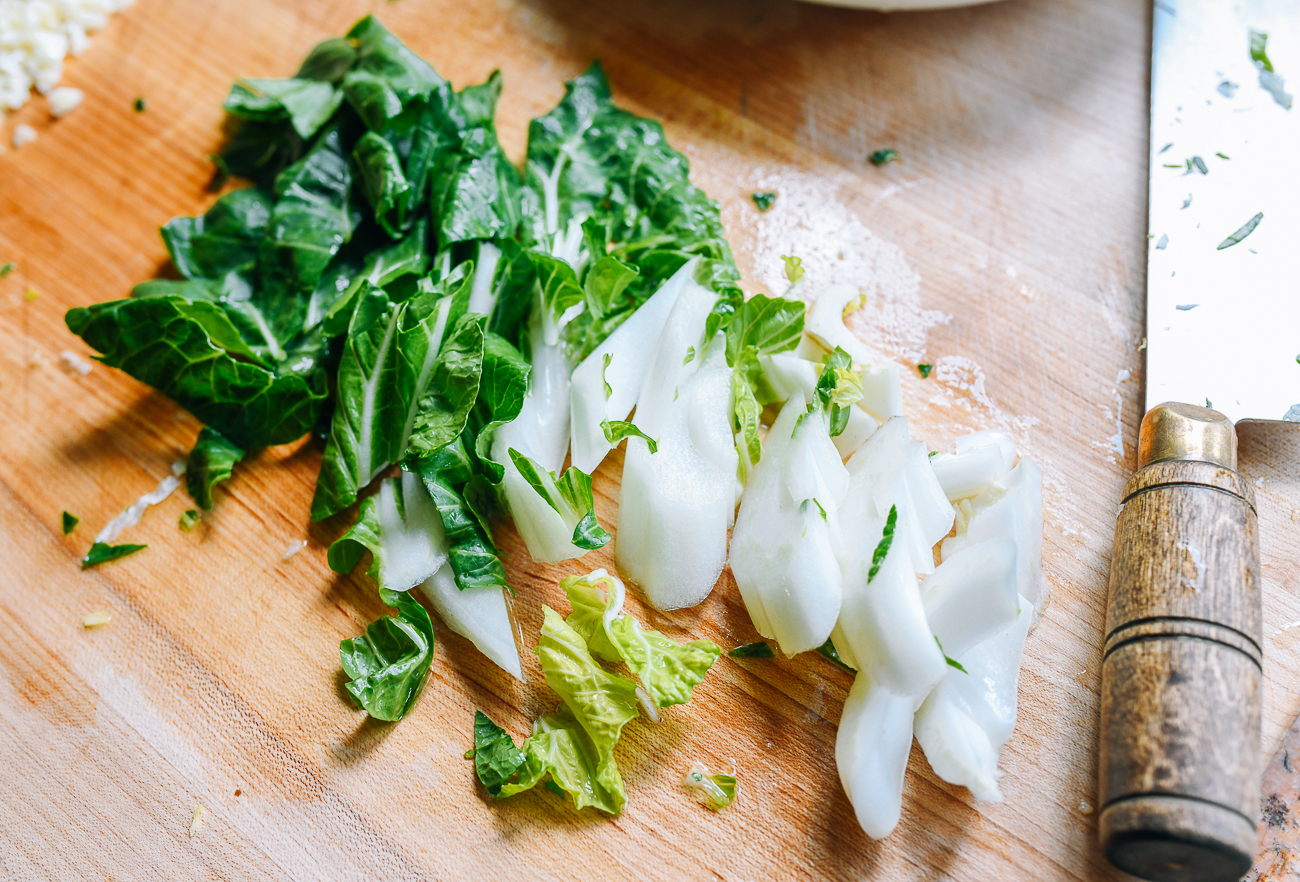
Throw the bok choy into a large bowl with lots of cold water. Agitate the veggies with your hands and/or use your faucet sprayer to loosen any dirt. Soak for 5 to 10 minutes (you can leave them for longer if you are prepping other things).
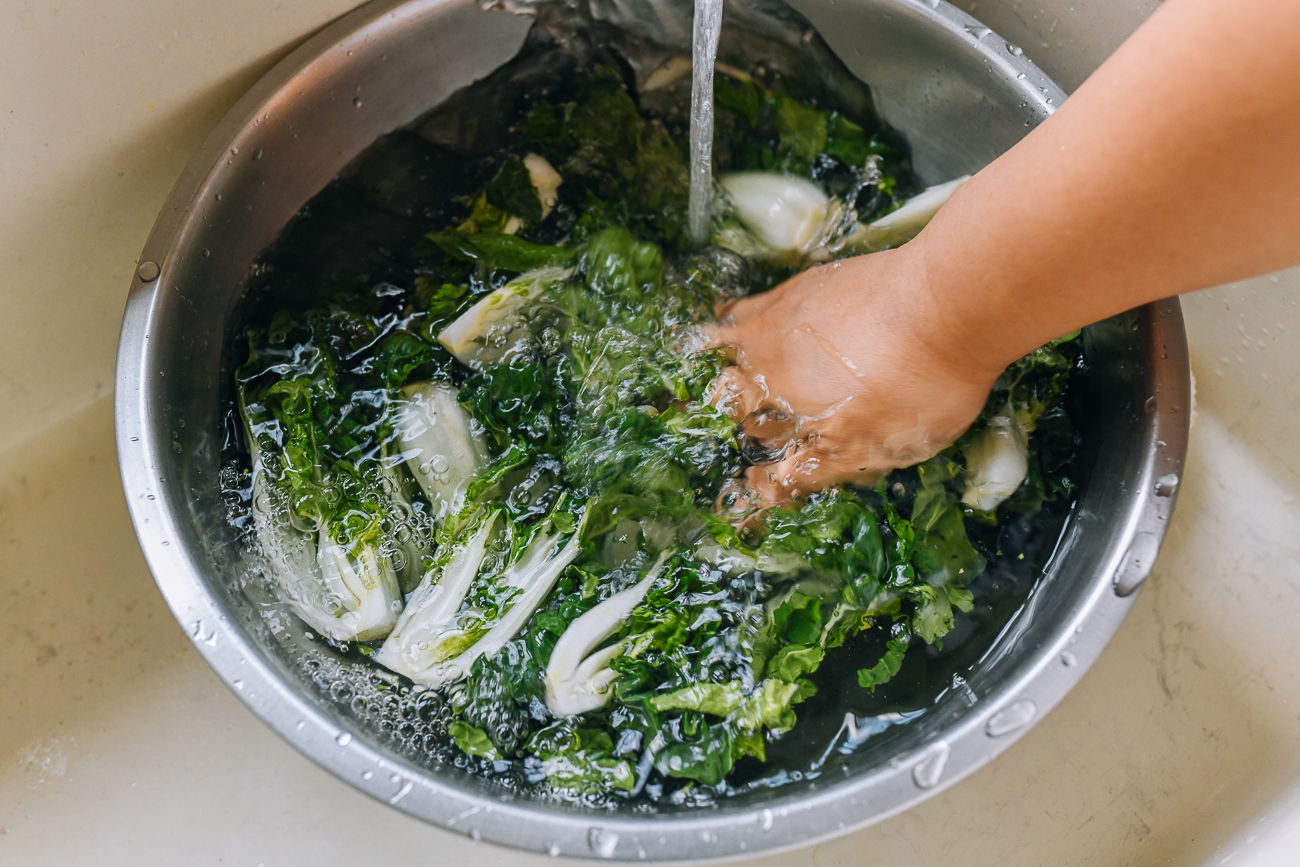
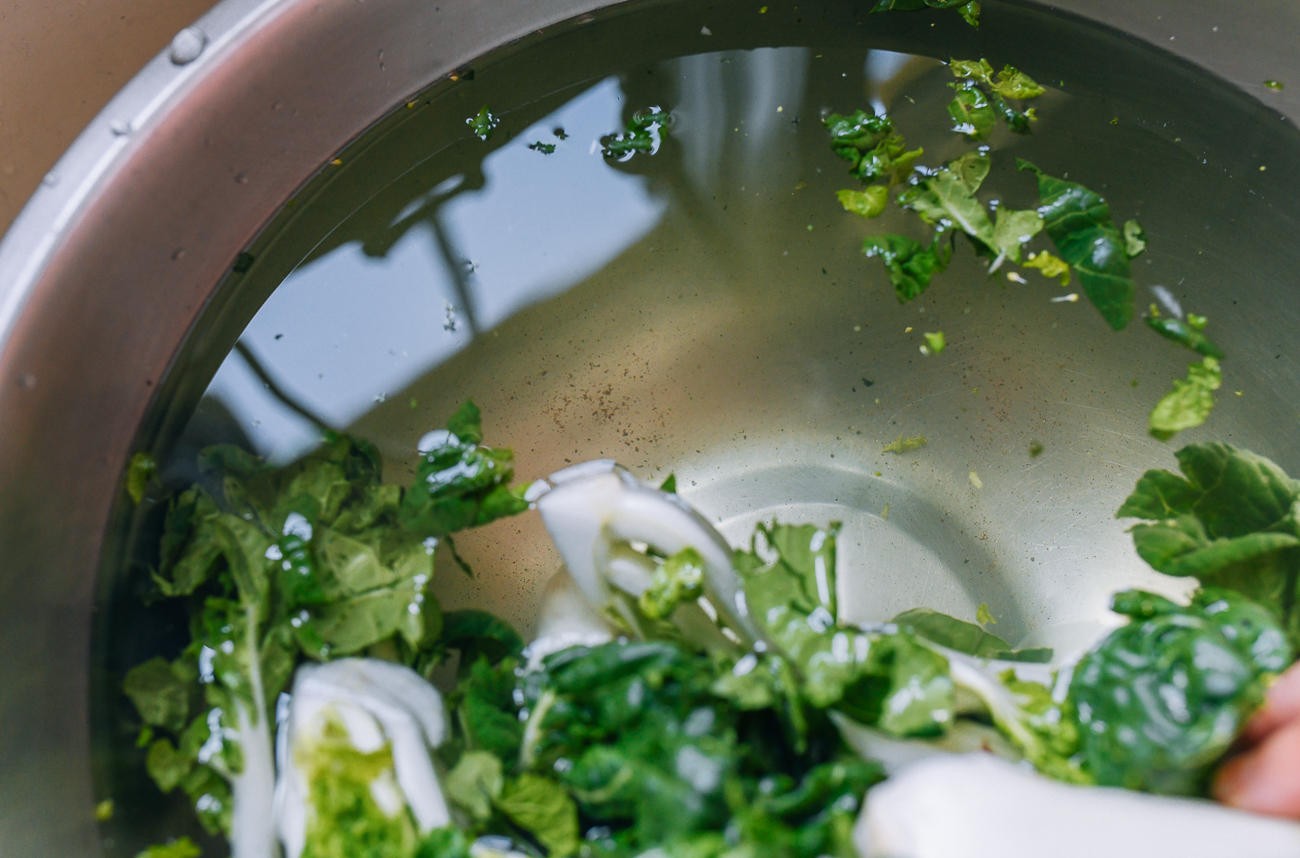
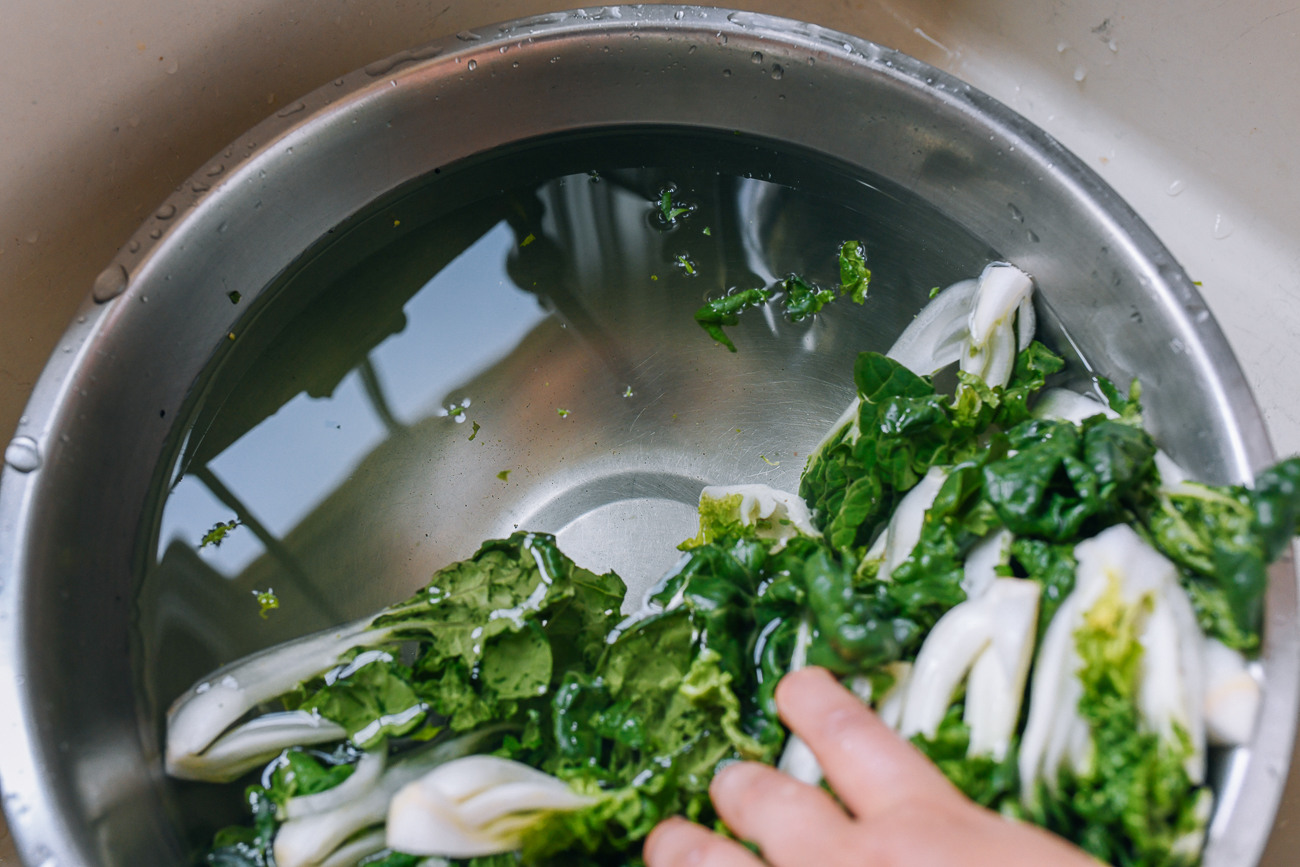
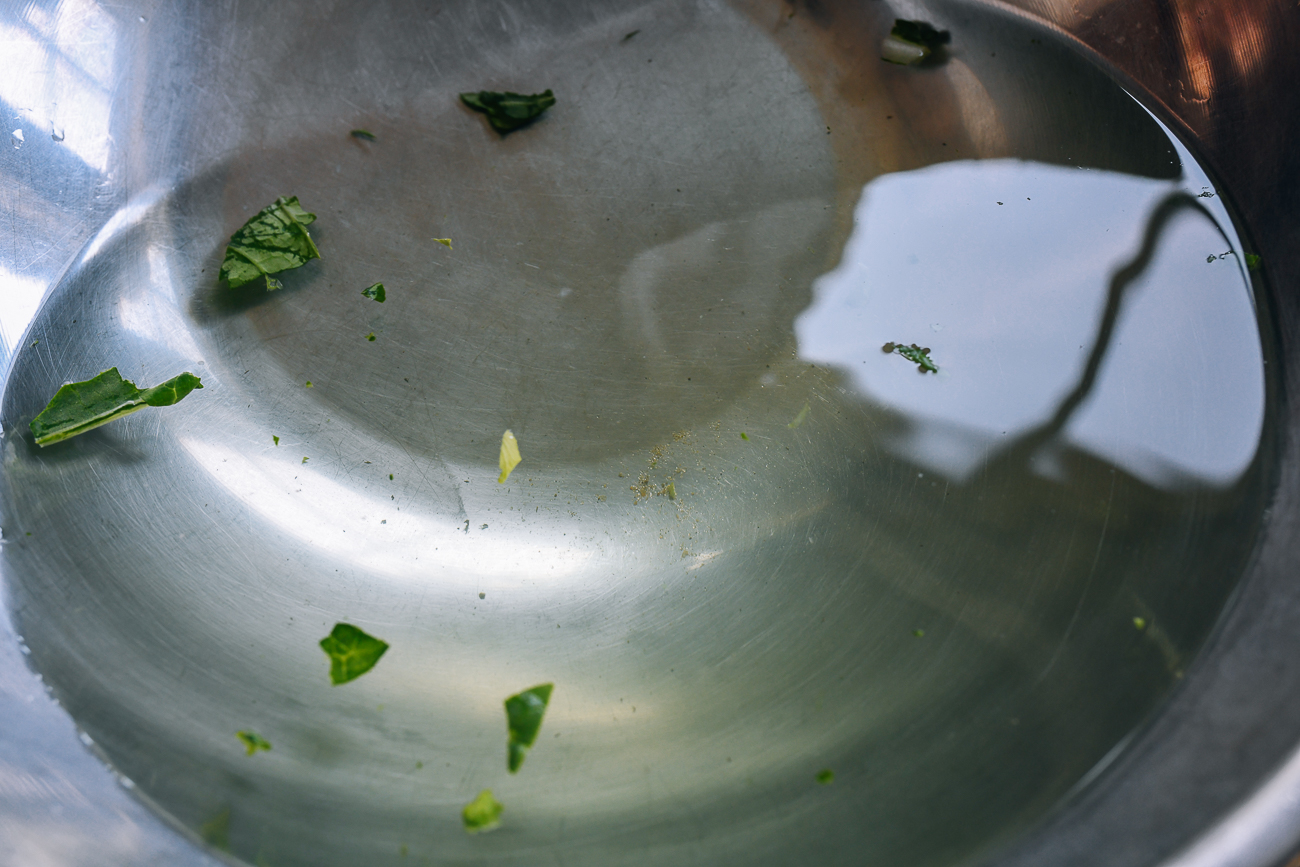
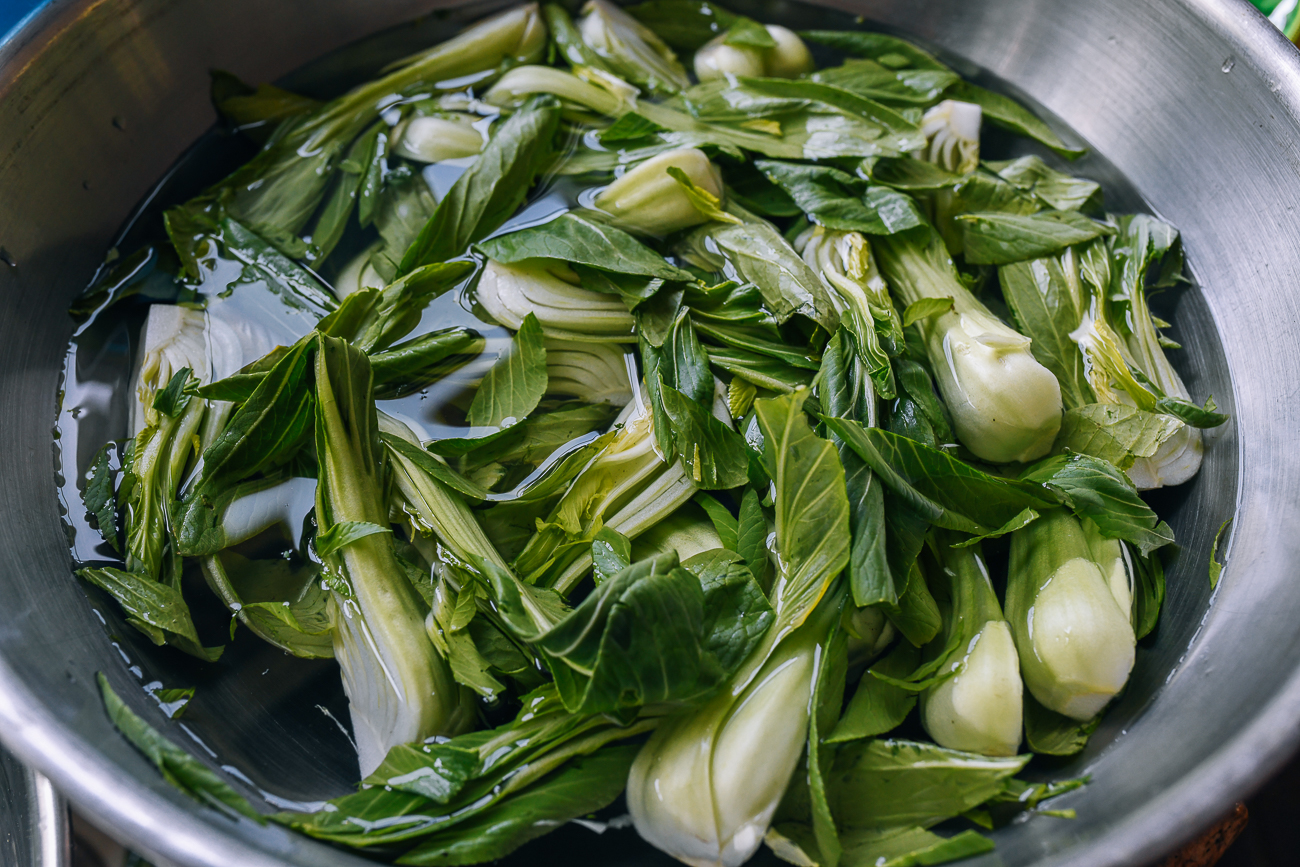
Scoop the veggies out of the water into a colander, and rinse the bowl clean of any sand. Repeat the process until you don’t see any dirt on the leaves or at the bottom of your bowl—usually 2 more times will do the trick. On the second or third soak, you can run your fingers on the stems to loosen any stubborn sand.
After the final wash, give your colander of bok choy a few good shakes to release any excess water.
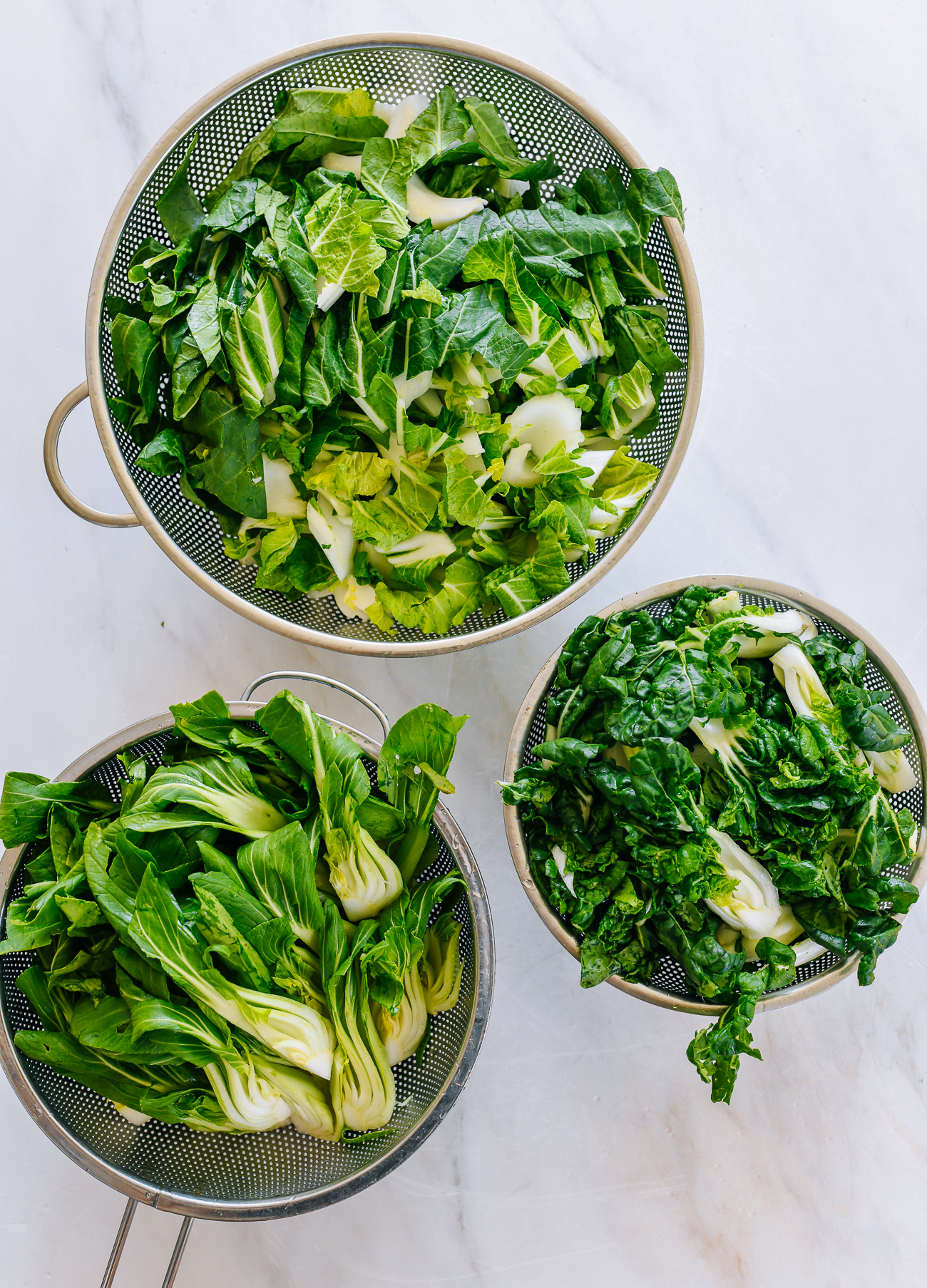
Note:
We tend to wash leafy greens three times, and use the water from each wash to water plants!
Cooking the Bok Choy:
Heat your wok or a large skillet or pan over low heat, and add the oil and ginger.
As you can see below, you can add a whole slice of ginger, julienned pieces, or minced ginger.
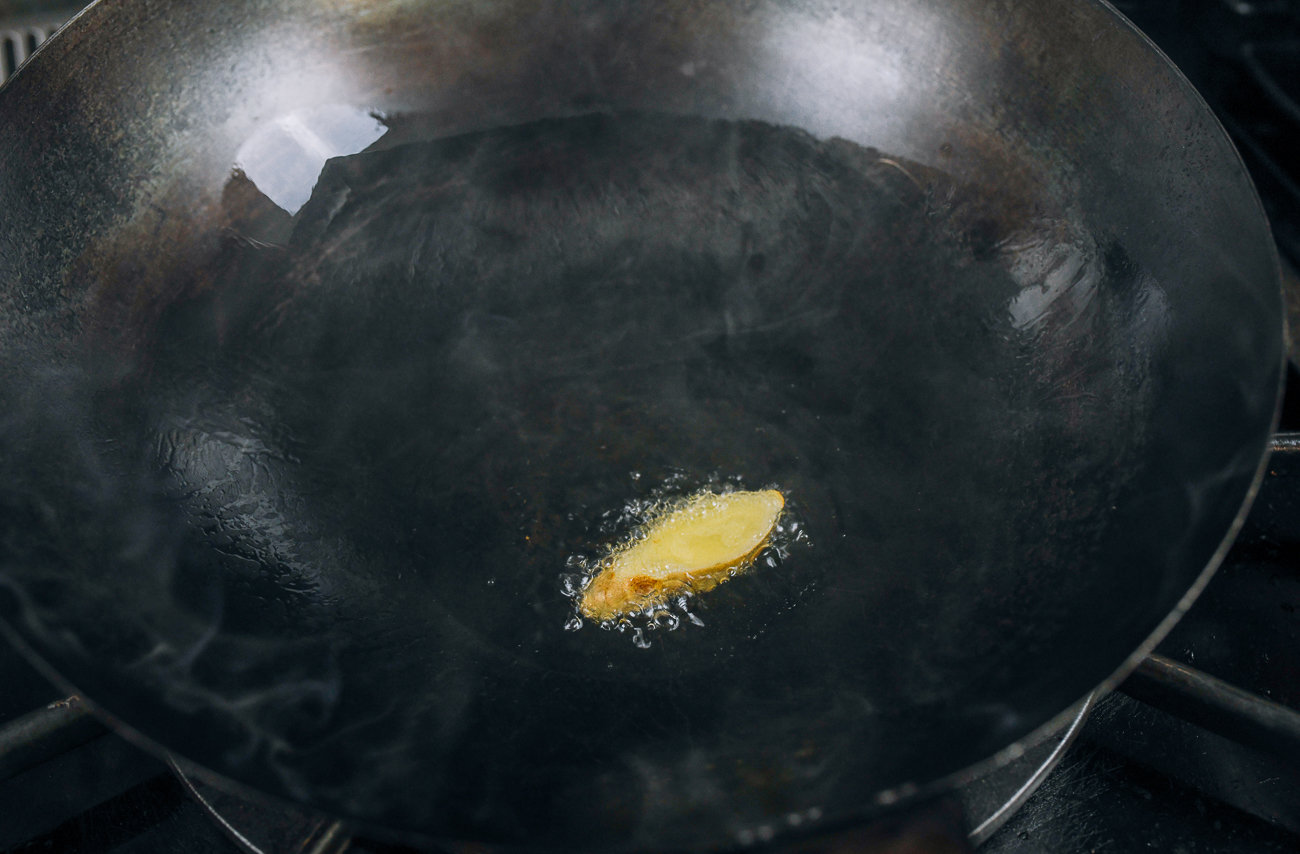
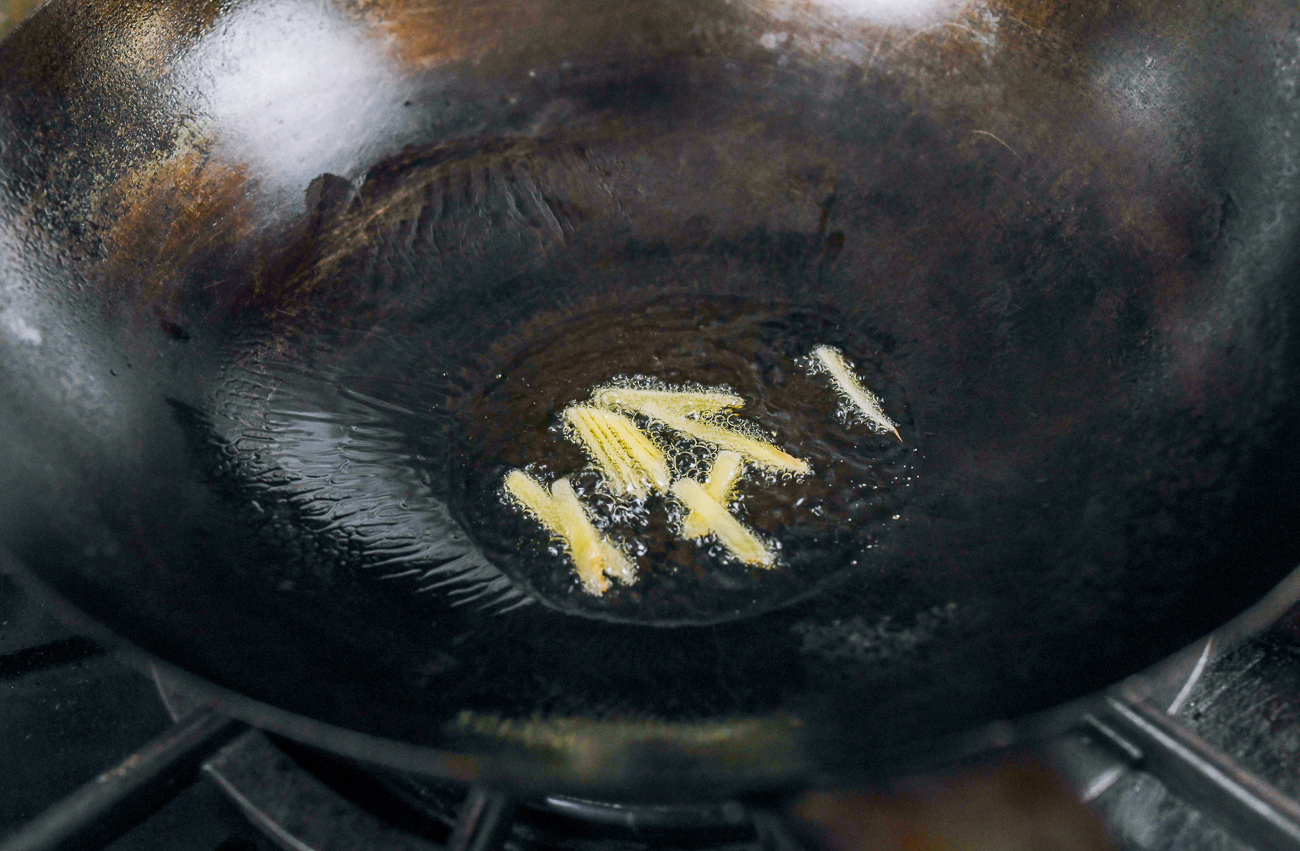
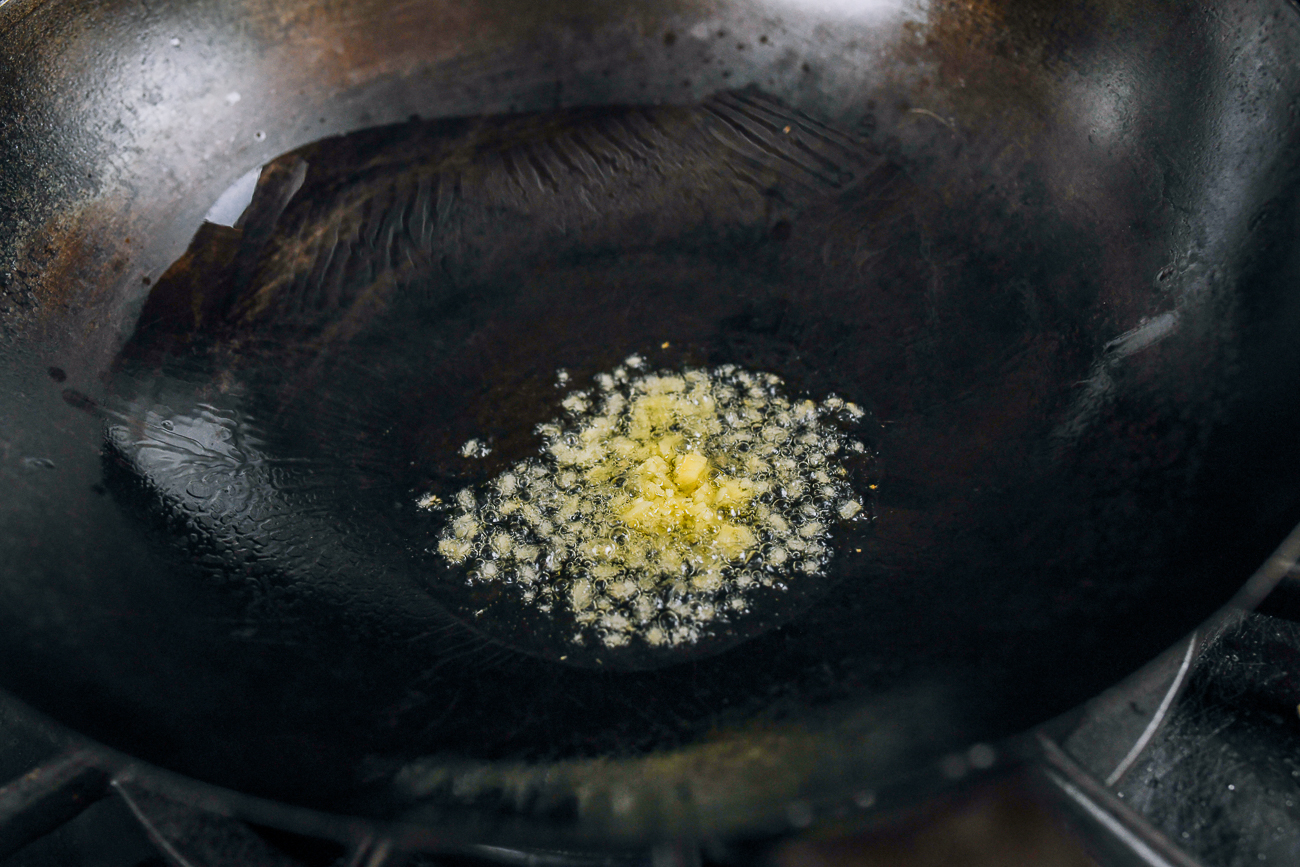
If you prefer a stronger garlicky flavor, add the garlic now. You can let it sizzle in the oil for 10-15 seconds, but don’t let it brown, or it will turn bitter. Add the veggies when the garlic is still white.
If you like a fresher, more mild garlic flavor, add it in after salting the vegetables.
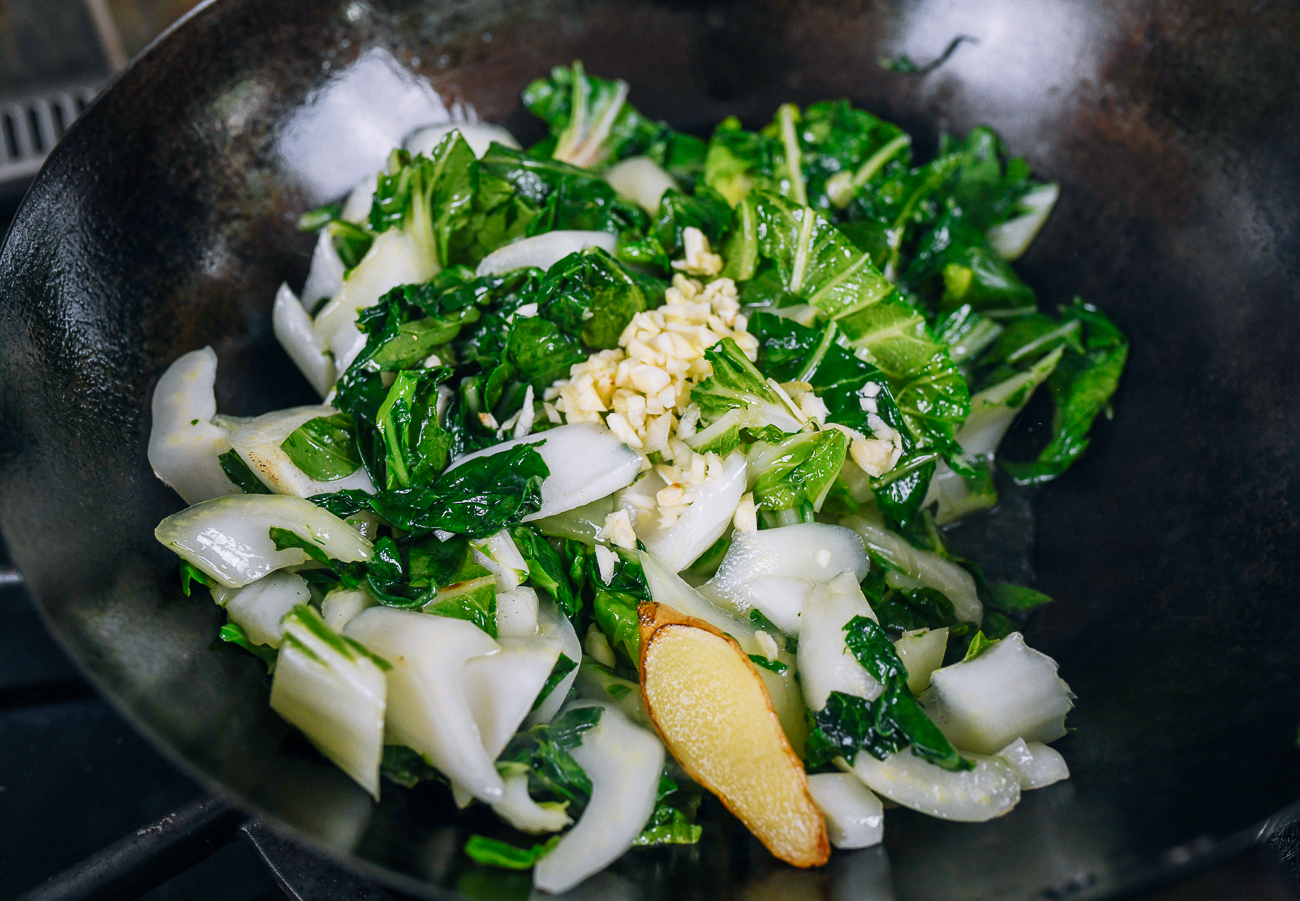
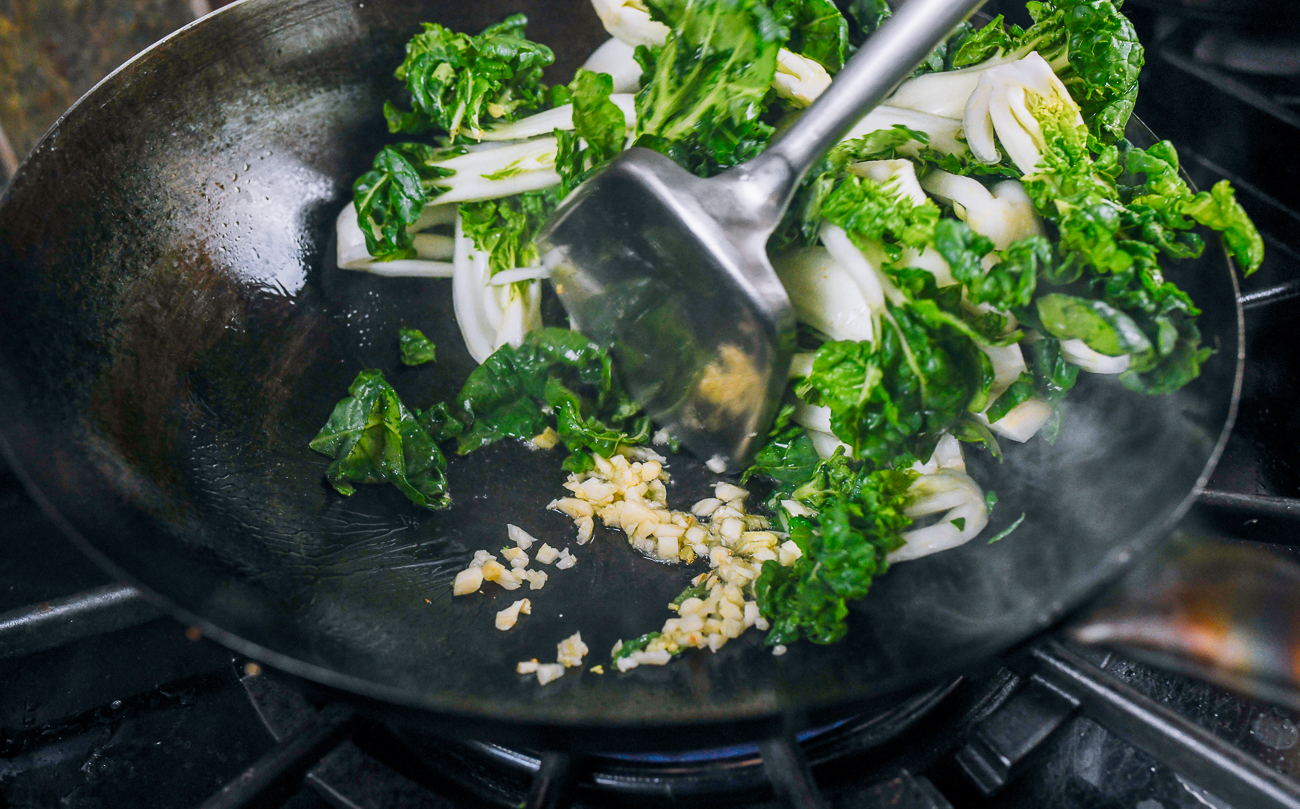
Tip!
If you don’t feel like mincing garlic, you can use a garlic press. It gives the dish a much more garlicky flavor.
Add the veggies, and increase the heat to high. Stir-fry using a scooping motion so the oil and aromatics are evenly distributed.
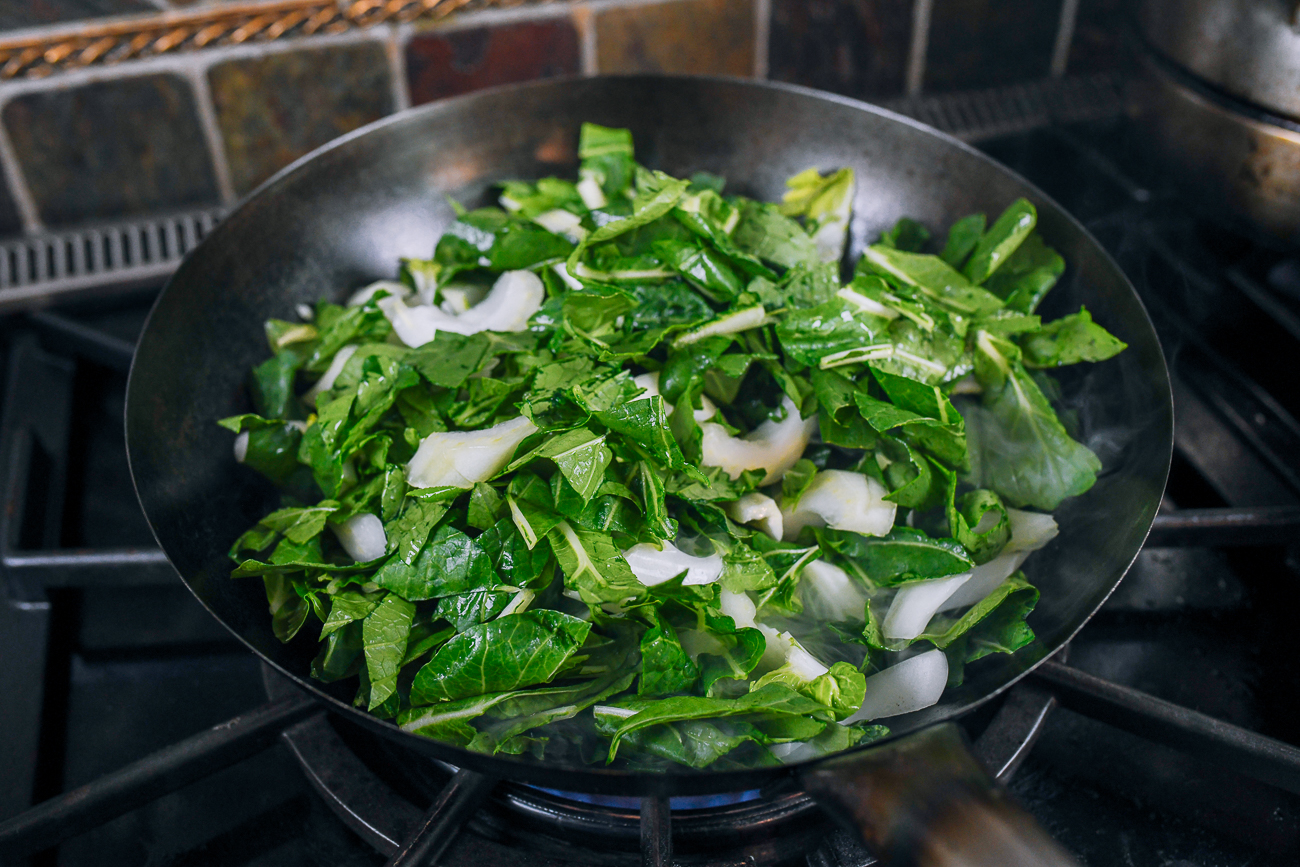
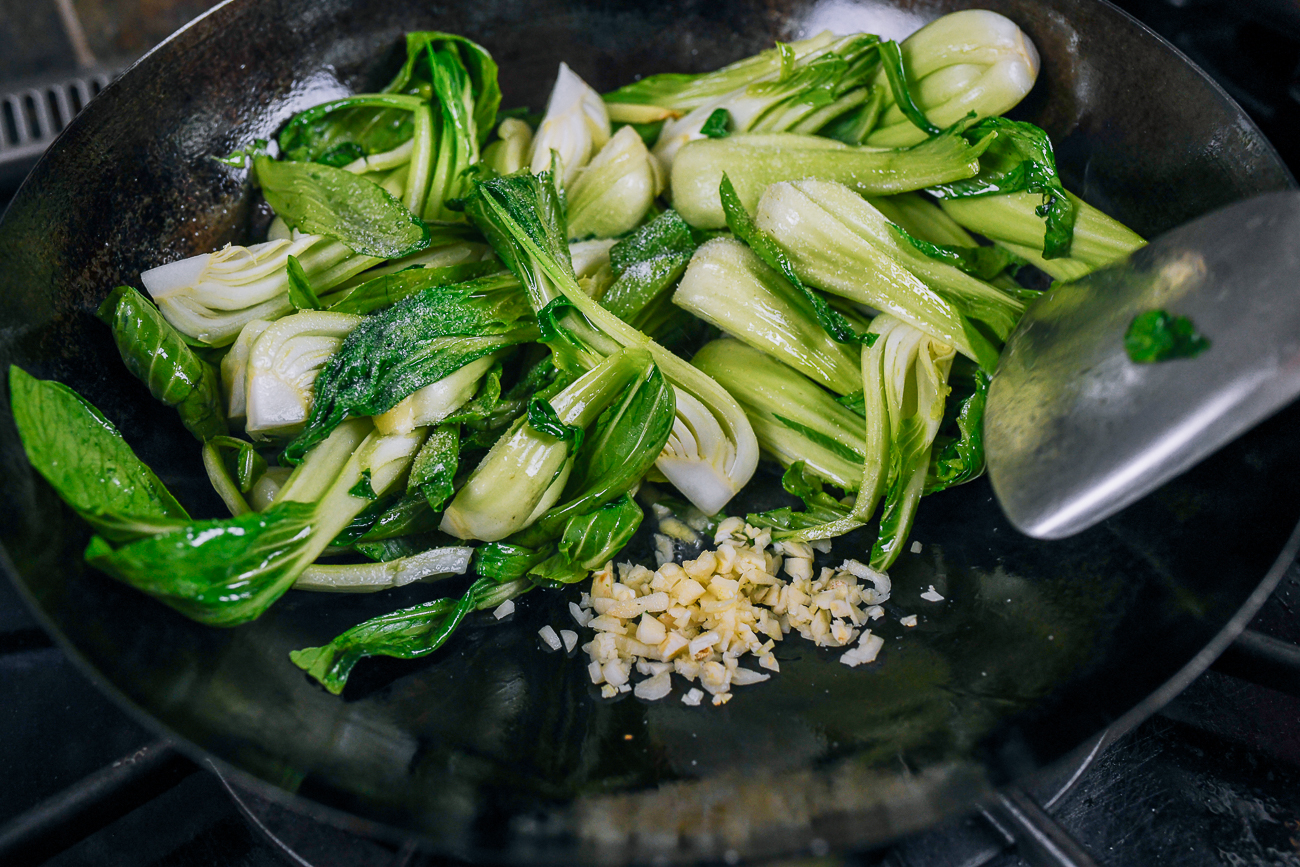
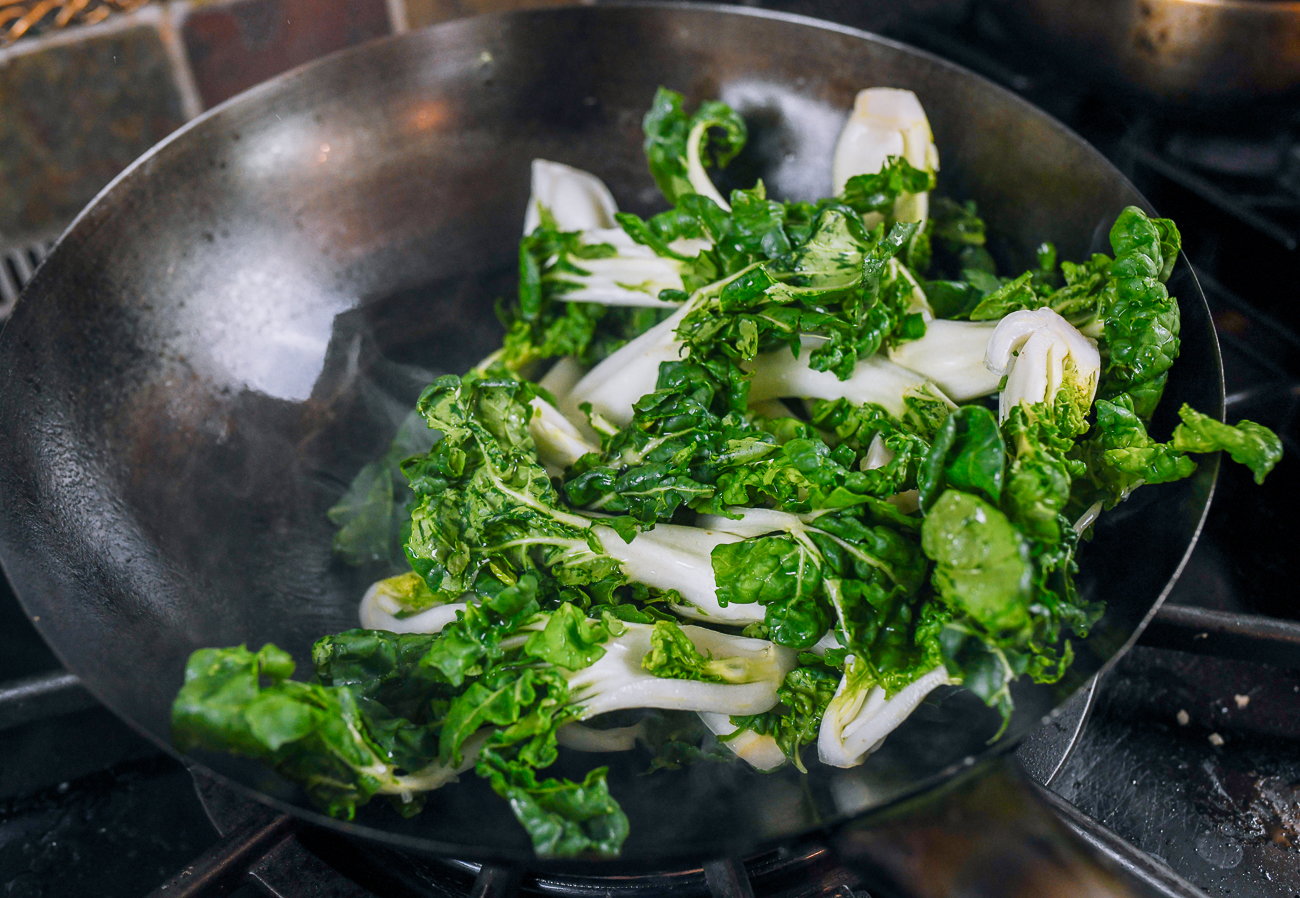
Next, add salt, sesame oil (if using), the MSG (if using), and the white pepper. Stir-fry for another 1-2 minutes, until the bok choy is just tender.
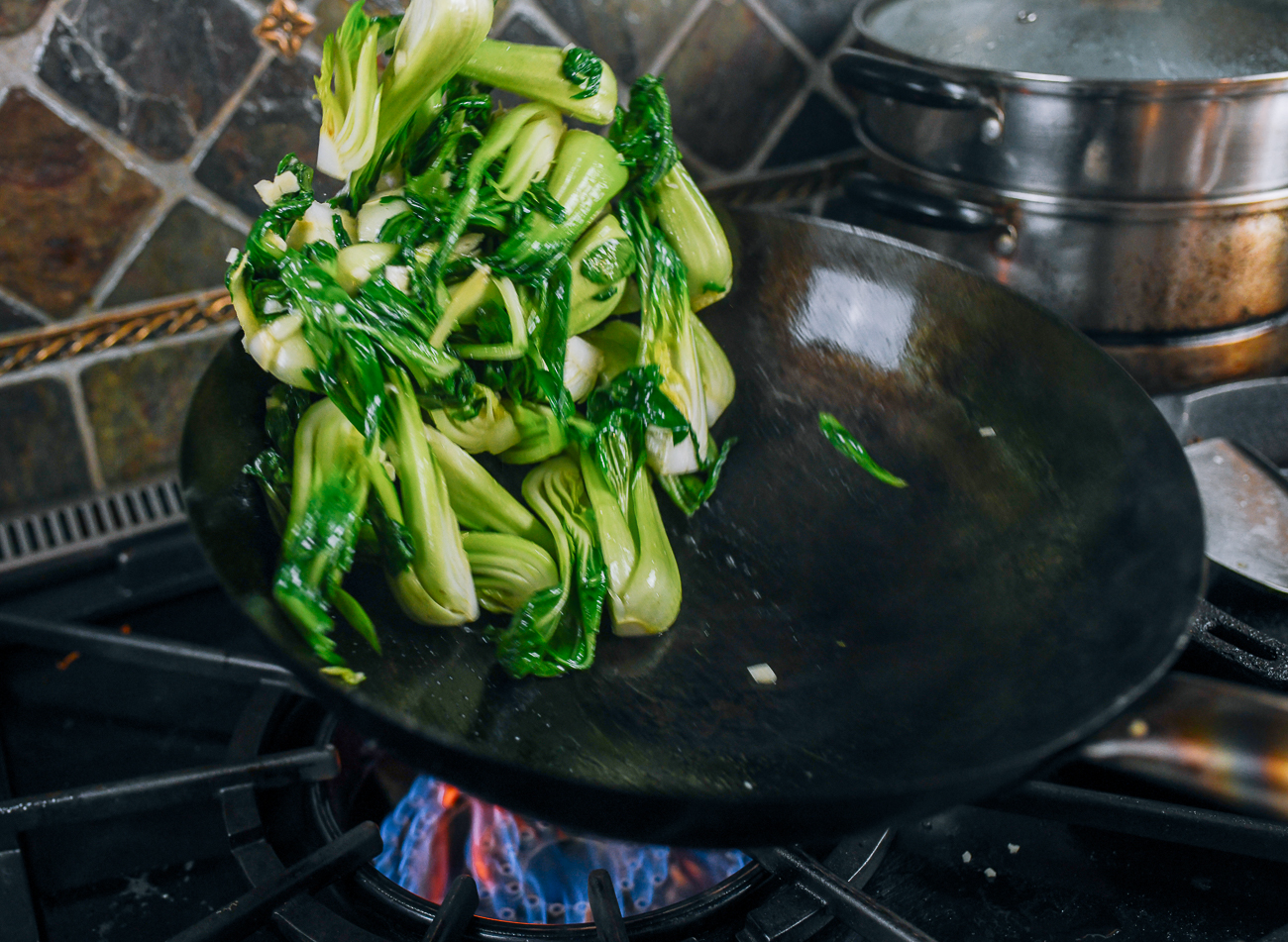
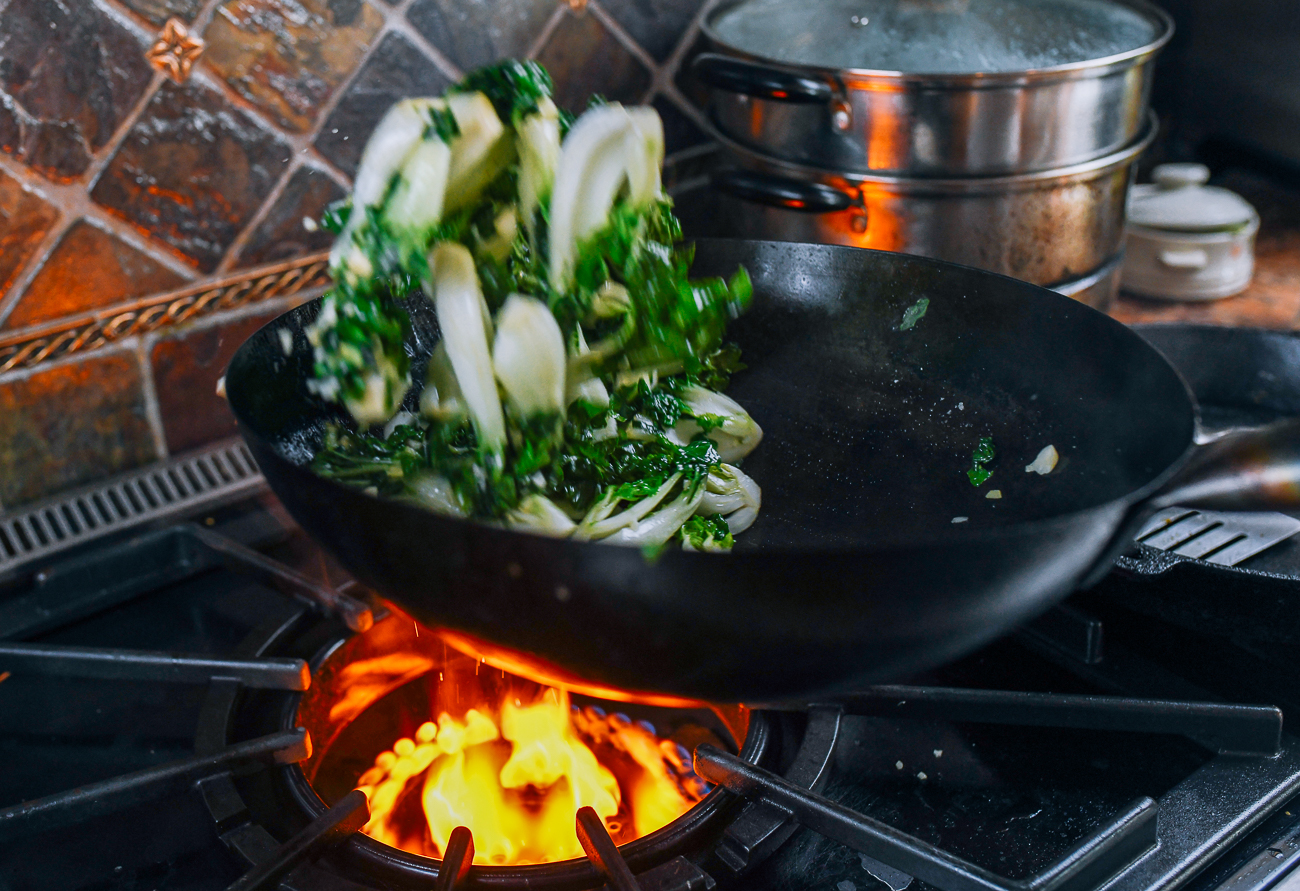
Finish off with the cornstarch slurry, adding it to the center of the vegetables. Toss the vegetables until they are glistening. Plate and serve immediately.
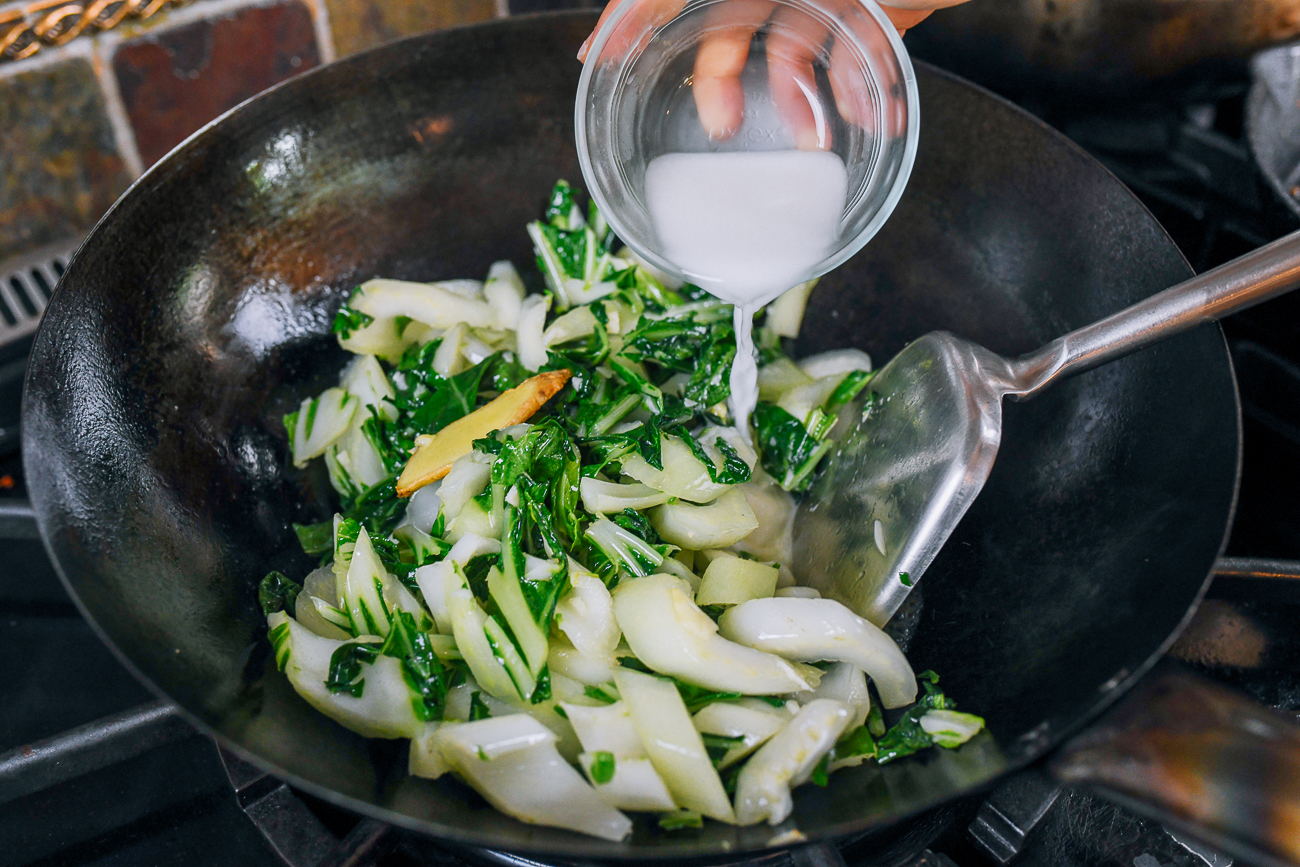
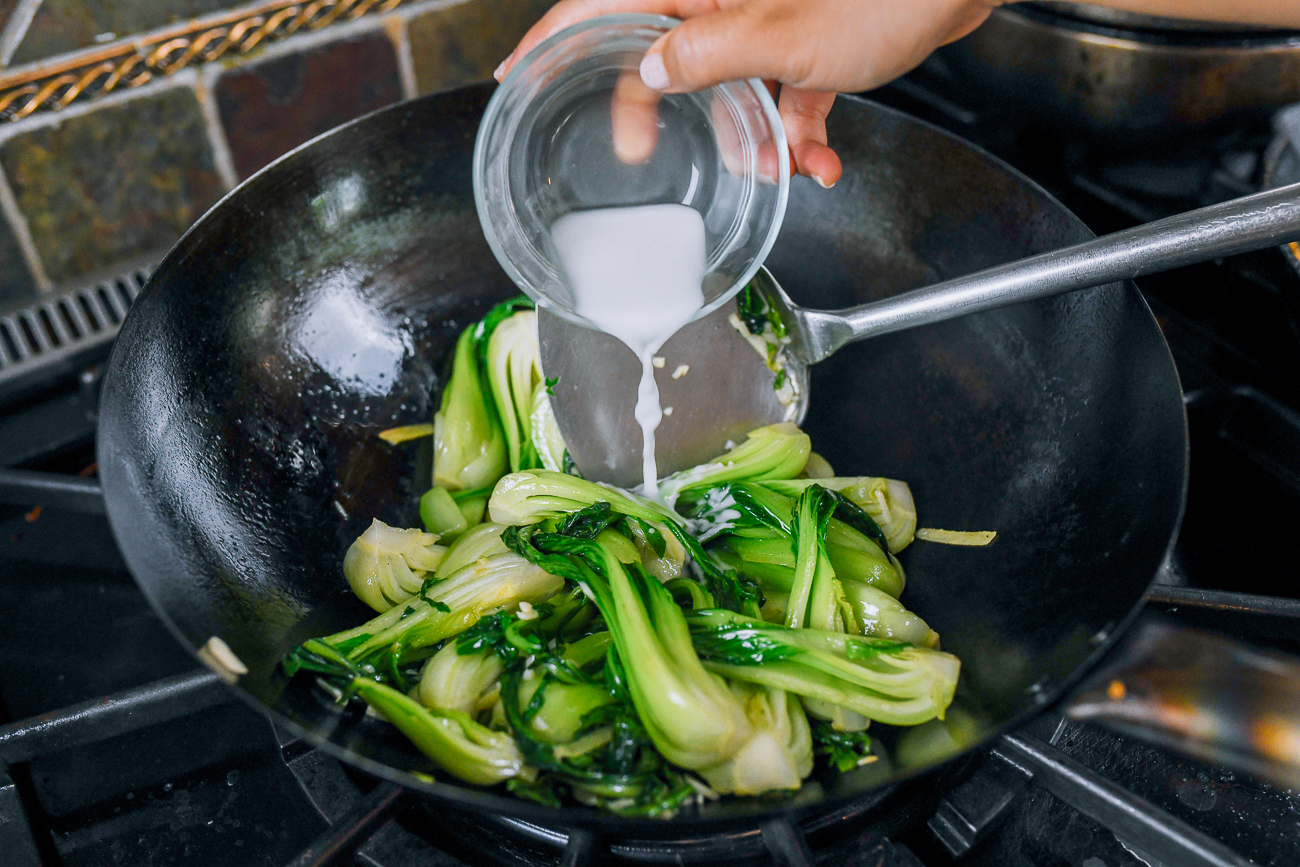
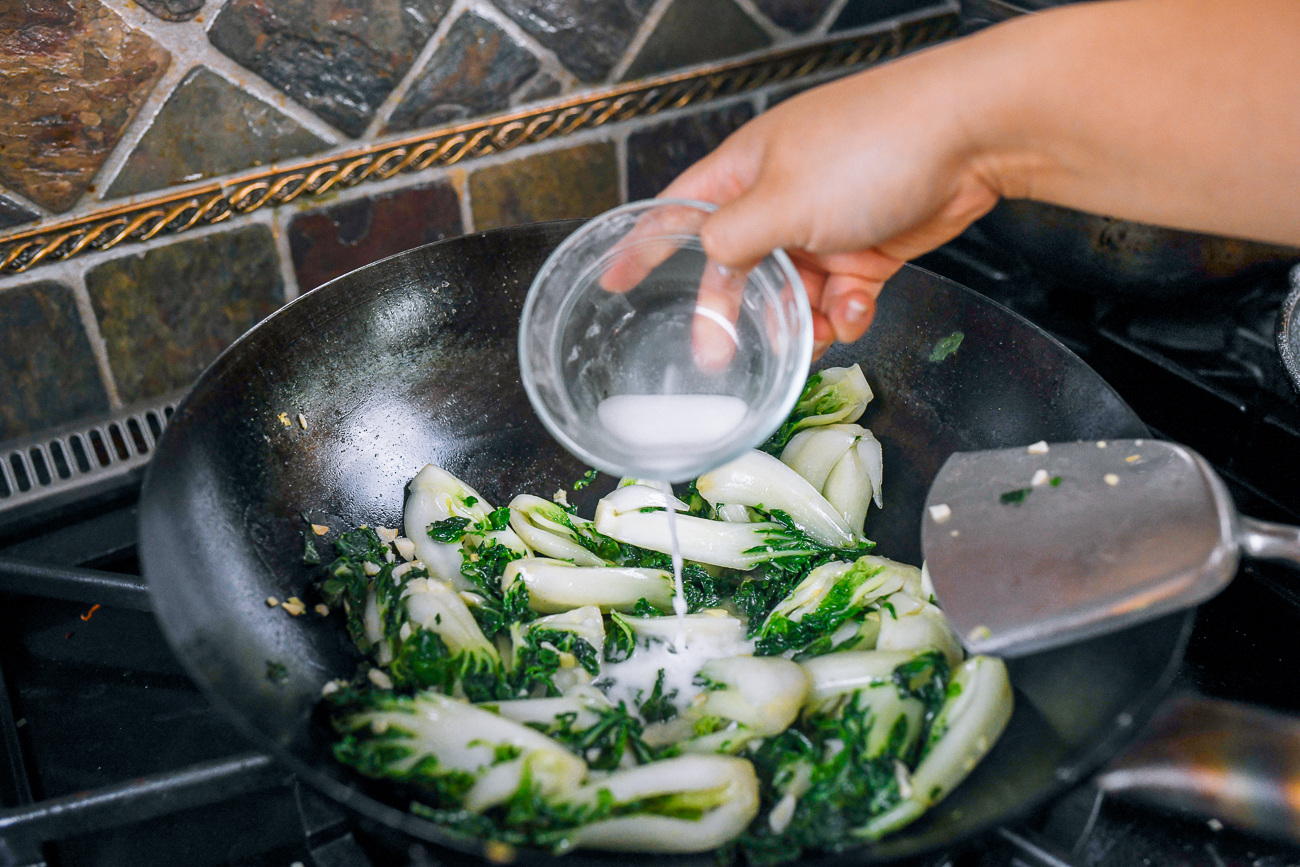
You may have a little or a lot of liquid, depending upon the heat of your stove and how much water was left in your vegetables after washing, so use a deep dish for serving. That veggie soup liquid is full of vitamins and is very nice when poured over a bit of rice!
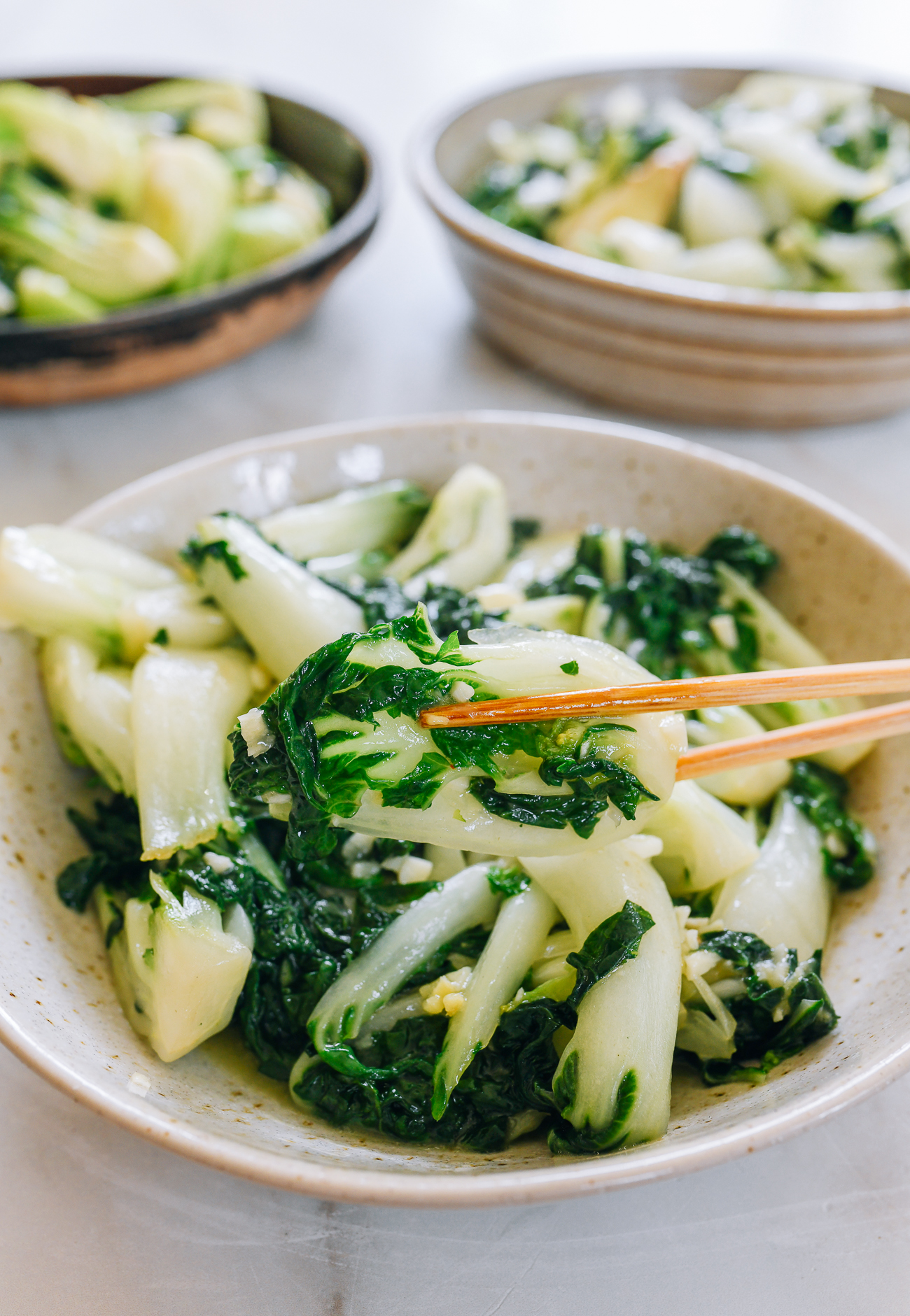
Bok Choy Stir-fry
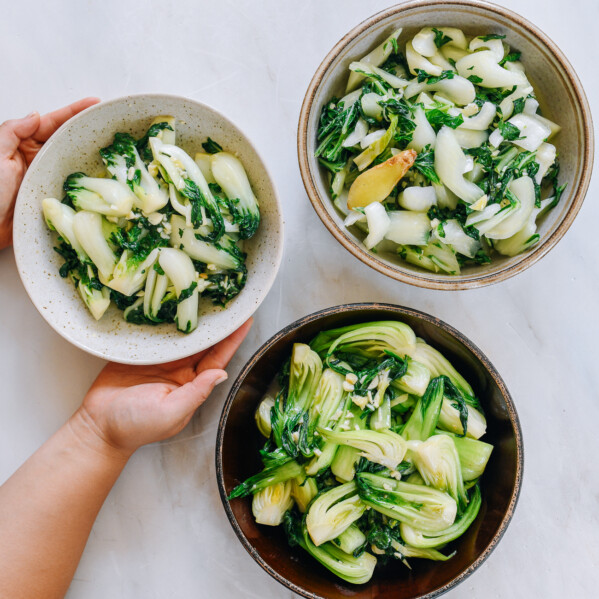
Ingredients
- 1½-1¾ pounds fresh bok choy (any variety; discard any yellowing leaves or bruised, browning stems)
- 3 tablespoons neutral oil (any with a higher smoke point, such as peanut, avocado, vegetable, canola, or light olive oil)
- 1 slice ginger (⅛-inch/3mm thick, 2-inches/5cm long; you can leave it as is, julienne it, or mince it. The more you break it down, the stronger the ginger flavor will be—we like it minced!)
- 4 large cloves garlic roughly chopped
- ½-¾ teaspoon salt (add higher end of range if not using MSG)
- ½ teaspoon sesame oil (optional—parents Bill & Judy like it, Sarah and Kaitlin don’t!)
- ⅛-¼ teaspoon MSG (optional)
- ⅛ teaspoon white pepper
- 1½ teaspoons cornstarch mixed into a slurry with 2 tablespoons (water)
Instructions
Prepare/Wash your Bok Choy
- If using smaller bok choy, cut them into halves lengthwise. Any pieces that look a bit too big can be cut into quarters. This will make them easier to eat and help loosen sand and dirt during washing.
- If using medium or large bok choy, separate the bulbs into individual stems. Trim away the tough base. If they’re very large, cut the bok choy at a slight angle into 1-inch pieces. Note that it’s easier to wash large bok choy leaves/stems before cutting.
- Throw the bok choy into a large bowl with lots of cold water. Agitate the veggies with your hands and/or use your faucet sprayer to loosen any dirt. Soak for 5 to 10 minutes (you can leave them for longer if you are prepping other things).
- Scoop the veggies out of the water into a colander, and rinse the bowl clean of any sand. Repeat the process until you don’t see any dirt on the leaves or at the bottom of your bowl—usually 2 more times will do the trick. On the second or third soak, you can run your fingers on the stems to loosen any stubborn sand.
- After the final wash, give your colander of bok choy a few good shakes to release any excess water.
Cooking the Bok Choy:
- Heat your wok or a large pan over low heat, and add the oil and ginger. If you prefer a stronger garlicky flavor, add the garlic now. You can let it sizzle in the oil for 10-15 seconds, but don’t let it brown, or it will turn bitter. Add the veggies when the garlic is still white. If you like a fresher, more mild garlic flavor, add it in after salting the vegetables.
- Add the veggies, and increase the heat to high. Stir-fry using a scooping motion so the oil and aromatics are evenly distributed.
- Next, add salt, sesame oil (if using), the MSG (if using), and the white pepper. Stir-fry for another 1-2 minutes. Finish off with the cornstarch slurry, adding it to the center of the vegetables. Toss the vegetables until they are glistening. Plate and serve immediately.
nutrition facts
Old Version of Recipe:
Ingredients:
2 pounds fresh large Bok Choy
3 tablespoons canola oil or light olive oil
¼ teaspoon freshly grated ginger (optional)
3 cloves garlic (minced)
½ teaspoon salt
⅛ teaspoon sugar
½ teaspoon sesame oil
⅛ teaspoon white pepper
⅛ teaspoon MSG (totally optional)
2 tablespoons hot chicken stock (optional)

Instructions:
Discard any yellowing leaves from your bok choy, and slice it at a slight angle into 1-inch pieces. When you reach the tough base of the stem, discard. Throw your bok choy into a large bowl with lots of cold water. Agitate the veggies with your hands and/or use your faucet sprayer to loosen any dirt. Soak for 5 to 10 minutes.
Scoop the veggies into a colander and rinse the bowl clean of any sand. Repeat the process until you don’t see any dirt on the leaves or at the bottom of your bowl. We tend to wash leafy greens three times, and then we use the water to water plants! Once the washed bok choy is in a colander, give it a good shake to release any excess water.
Heat your wok or large pan over low heat and add the oil. Immediately add the ginger first (if using) and then the garlic (if you don’t feel like mincing garlic, you can use a garlic press, one of our most often used kitchen tools! It gives the dish a much more garlicky flavor.).
Once you have the ginger and garlic in the pan, add the veggies and turn the heat up to the highest setting. Stir-fry using a scooping motion so the ginger, garlic and oil are evenly distributed among the vegetables. This first 30 seconds is a critical time not to let your aromatics burn and to cook your veggies evenly.
Next, add salt, sugar, sesame oil, white pepper, and the MSG and hot chicken stock if using. (Using hot chicken stock is important to maintaining the temperature of the wok). Stir fry uncovered for another 1-2 minutes. Plate and serve immediately.
You may have a little or a lot of liquid, depending upon the heat of your stove and how much water was left in your vegetables after washing, so use a deep dish for serving.
